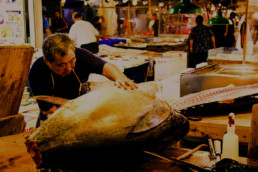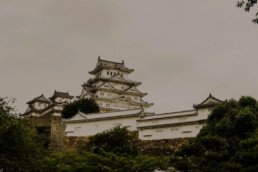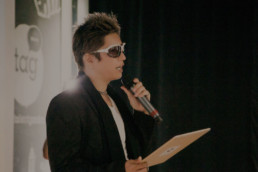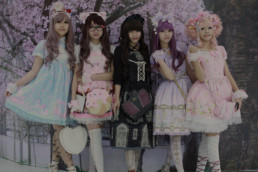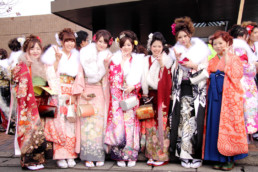Japan Travel: Il Palazzo Imperiale e giardini Imperiali

photo credit: Google Images
Sono stata a Tokyo un paio di volte e uno dei miei posti preferiti in tutta la città sono i giardini imperiali nell'area di Chiyoda. Ogni volta che sono in città, trovo sempre un momento (a volte anche più di uno) per visitare questo incredibile posto, un cuore verde a Tokyo, pieno di storia e tradizione ma circondato dalla modernità di questa frenetica città.
Il Palazzo Imperiale di Tokyo (皇居 Kōkyo, letteralmente "Residenza Imperiale") è la residenza principale dell'Imperatore del Giappone. Con i suoi grandi parchi si trova nel cuore del quartiere di Chiyoda e contiene edifici tra cui il palazzo principale (宮殿 Kyūden), le residenze private della famiglia imperiale, un archivio, musei e uffici amministrativi.
L'attuale palazzo è costruito sul sito del vecchio castello Edo costruito dallo shogun Tokugawa Ieyasu e l'area totale, compresi i giardini, è di 1,15 chilometri quadrati.
La storia
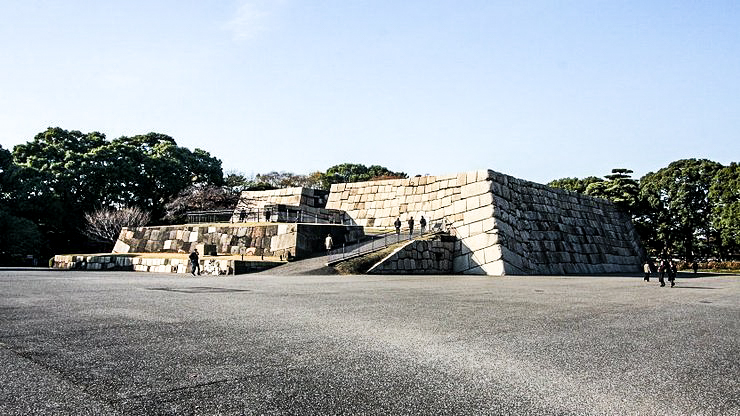

photo credit: japan-guide.com
Castello di Edo
Costruito da Tokugawa Ieyasu e assegnato come residenza della famiglia Tokugawa, dopo la fine dello shogunato e la restaurazione Meiji, l'imperatore lasciò il palazzo imperiale di Kyoto e si trasferì nel castello di Edo. Questa divenne la sua nuova residenza e fu ribattezzata con il nome di Castello di Tōkei (東京城 Tōkei-jō), nello stesso periodo, anche Tōkyō era stata chiamata Tōkei.
Il 5 maggio 1873, il palazzo Nishinomaru (precedentemente residenza dello shogun) fu distrutto da un incendio e nel 1888 fu costruito il nuovo Palazzo Imperiale (宮城 Kyūjō).
L'organizzazione no-profit "Rebuilding Edo-jo Association" (NPO 法人 江戸城再建) fondata nel 2004 ha l'obiettivo di una ricostruzione storicamente corretta almeno del principale mastio. Questo gruppo progetta di raccogliere donazioni e firme su una petizione a sostegno della ricostruzione della torre del vecchio castello in modo che la capitale possa avere un edificio simbolico.


photo credit: Wikipedia, thetraveltester.com
Il vecchio palazzo
Nell'era Meiji, la maggior parte delle strutture del castello di Edo scomparve. Alcuni sono stati rimossi per far posto ad altri edifici mentre altri sono stati distrutti da terremoti e incendi.
In questo caso, i ponti doppi di legno (二重橋 Nijūbashi) sopra il fossato furono sostituiti con ponti di pietra e ferro mentre gli edifici del Palazzo Imperiale costruiti nell'era Meiji erano fatti di legno.
Quando ti trovi per la prima volta il Palazzo Imperiale, vieni improvvisamente trasportato nell'architettura giapponese classica e tradizionale, ma se avete la possibilità di camminare in quelle sale coprirete che all'interno, il palazzo è un misto della moda giapponese di allora ed elementi europei. Sedie occidentali, tavoli e tende pesanti arredano gli spazi, i pavimenti delle sale comuni hanno parquets o tappeti mentre gli spazi residenziali usavano tatami tradizionali.
Gli ospiti erano ricevuti nella sala delle udienze principale, che era la parte centrale del palazzo. Il suo spazio era più di 223 tsubo (circa 737,25 m2) e il soffitto era in tradizionale stile giapponese, mentre il pavimento era fatto di parquet. Per il tetto, è stato mantenuto uno stile simile al Palazzo Imperiale di Kyoto, tuttavia fu coperto con lastre di rame ignifugato piuttosto che le tradizionali lastre di cipresso giapponesi.
Altri edifici in cemento furono aggiunti nel tardo periodo Taishō e all'inizio del periodo Shōwa, come il quartier generale del Ministero della casa imperiale e il Consiglio privato.
Durante la Seconda Guerra Mondiale, la notte del 25 maggio 1945, la maggior parte delle strutture del palazzo imperiale furono distrutte durante il bombardamento incendiario di Tokyo da parte delle forze alleate. A causa di ciò, una nuova sala principale del palazzo (宮殿 Kyūden) e le residenze furono costruite nella parte occidentale del sito negli anni '60 e questa zona fu ribattezzata Residenza Imperiale (皇居 Kōkyo) mentre la parte orientale fu ribattezzata East Garden (東 御苑 Higashi -Gyoen) e divenne un parco pubblico nel 1968.
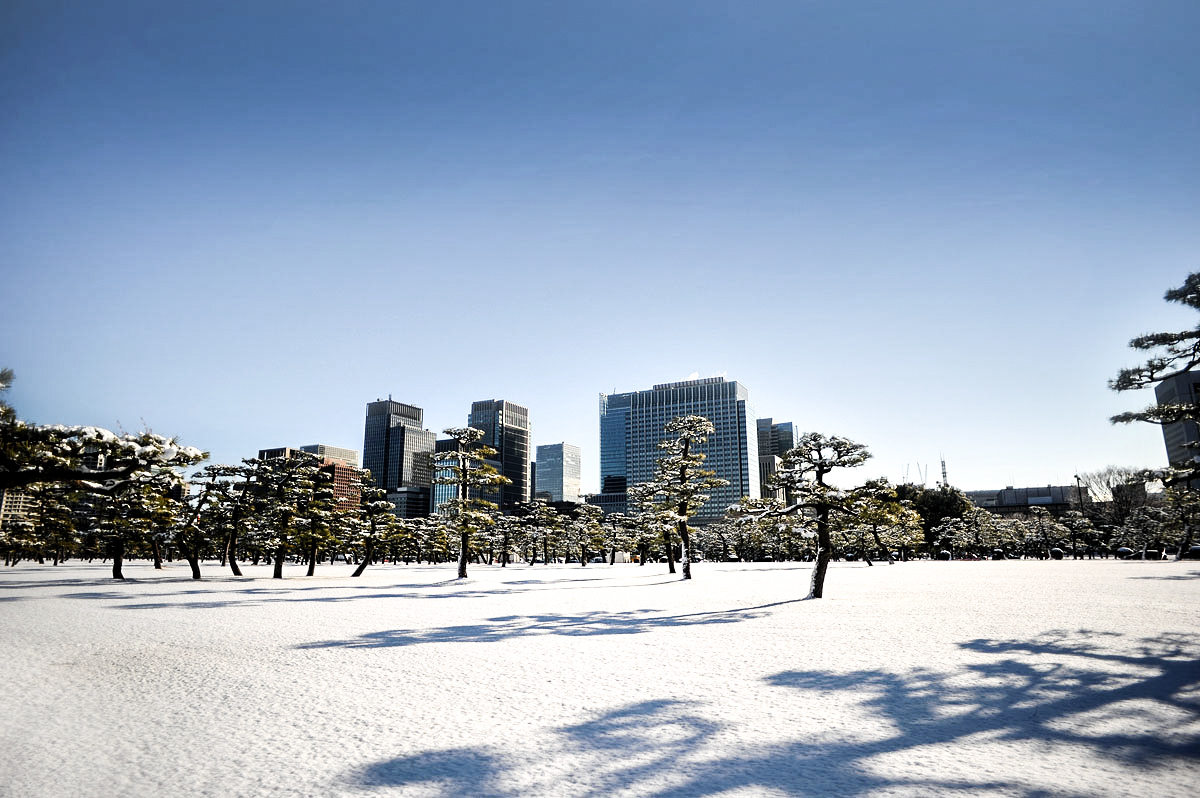
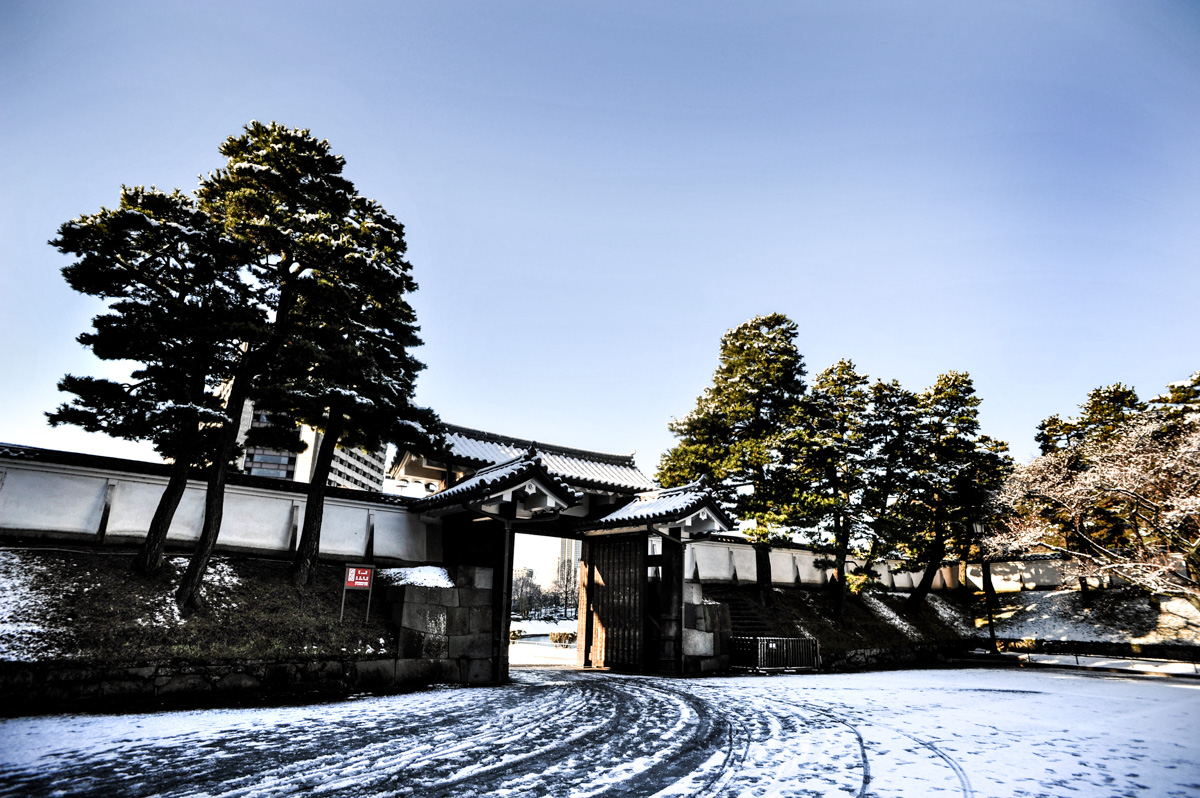
photo credit: tokyobling.wordpress.com
Il palazzo imperiale oggi
Dopo essere sopravvissuto alla definizione del momento storico, il moderno palazzo Kyūden (宮殿) fu progettato per varie funzioni giudiziarie imperiali e la reception si trova nella vecchia sezione Nishinomaru del palazzo.
Ad oggi, la residenza dell'attuale imperatore e imperatrice si trova nei giardini Fukiage ed è ora su una scala molto più modesta, rispetto a quella che era originariamente.
Ad eccezione dell’Imperial Household Agency e dei Giardini Imperiali, il palazzo è generalmente chiuso al pubblico, ad eccezione di visite guidate riservate da martedì a sabato. Ogni anno nuovo (2 gennaio) e al compleanno dell'imperatore, al pubblico è permesso di entrare attraverso il Nakamon (porta interna) dove si riuniscono nella Piazza Kyote Totei davanti alla Sala Chowaden. In questa occasione, la Famiglia Imperiale appare sul balcone davanti alla folla e l'Imperatore di solito fa un breve discorso di saluto, ringrazia gli ospiti e augura loro buona salute e benedizioni.
I giardini
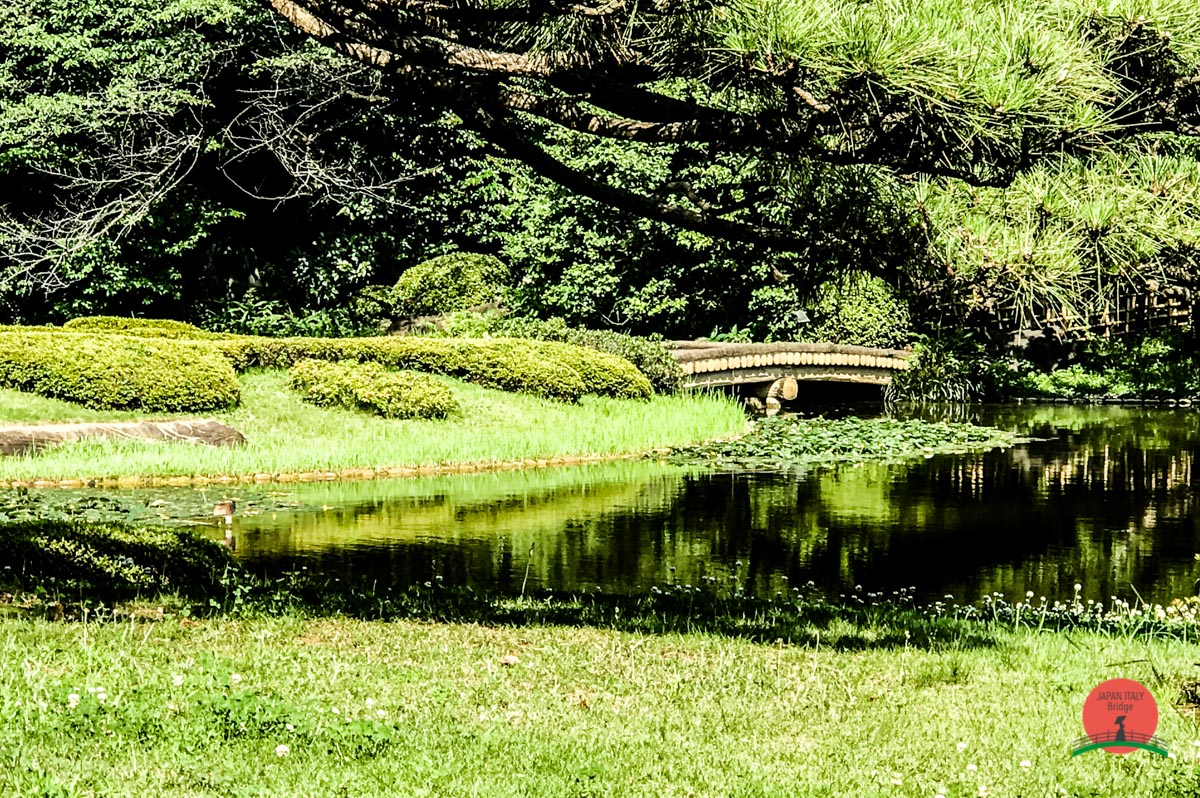

Fukiage Garden
Questo è probabilmente il giardino più antico del complesso. Il giardino Fukiage ha portato questo nome sin dal periodo Edo ed è qui che vive la famiglia imperiale.
Il Fukiage Ōmiya Palace (吹 上 大 宮 御所 Fukiage Ōmiya-gosho) nella parte settentrionale era originariamente la residenza dell'imperatore Showa e dell'imperatrice Kōjun e si chiamava Fukiage Palace. Dopo la morte dell'imperatore nel 1989, il palazzo fu ribattezzato Palazzo Fukiage Ōmiya e fu la residenza dell'Imperatrice Dowager fino alla sua morte nel 2000.
Qui potete anche trovare i Tre Santuari del Palazzo (宮中三殿 Kyūchū-sanden), parti delle Regalie Imperiali del Giappone e il santuario svolge un ruolo religioso nelle incoronazioni e matrimoni imperiali.


photo credit: Wikipedia
Tōkagakudō (Music Hall)
Il Tōkagakudō (桃華楽堂, Peach Blossom Music Hall) si trova ad est dell'ex mastio principale del castello di Edo nella zona Honmaru ed è stato costruito per commemorare il sessantesimo compleanno dell'imperatrice Kōjun il 6 marzo 1963. L'edificio di in ferro e cemento copre un'area totale di 1.254 m2 e ognuna delle sue otto pareti esterne è decorata con tessere di mosaico diversamente progettate.
Giardino Ninomaru
Se volete dare una rapida occhiata all'intera vegetazione giapponese, è qui che dovreste andare, dato che gli alberi simbolici che rappresentano ogni prefettura sono piantati nell'angolo nord-occidentale della cinta di Ninomaru. Tali alberi sono stati donati da ogni prefettura e ci sono in totale 260 alberi, coprendo 30 varietà.

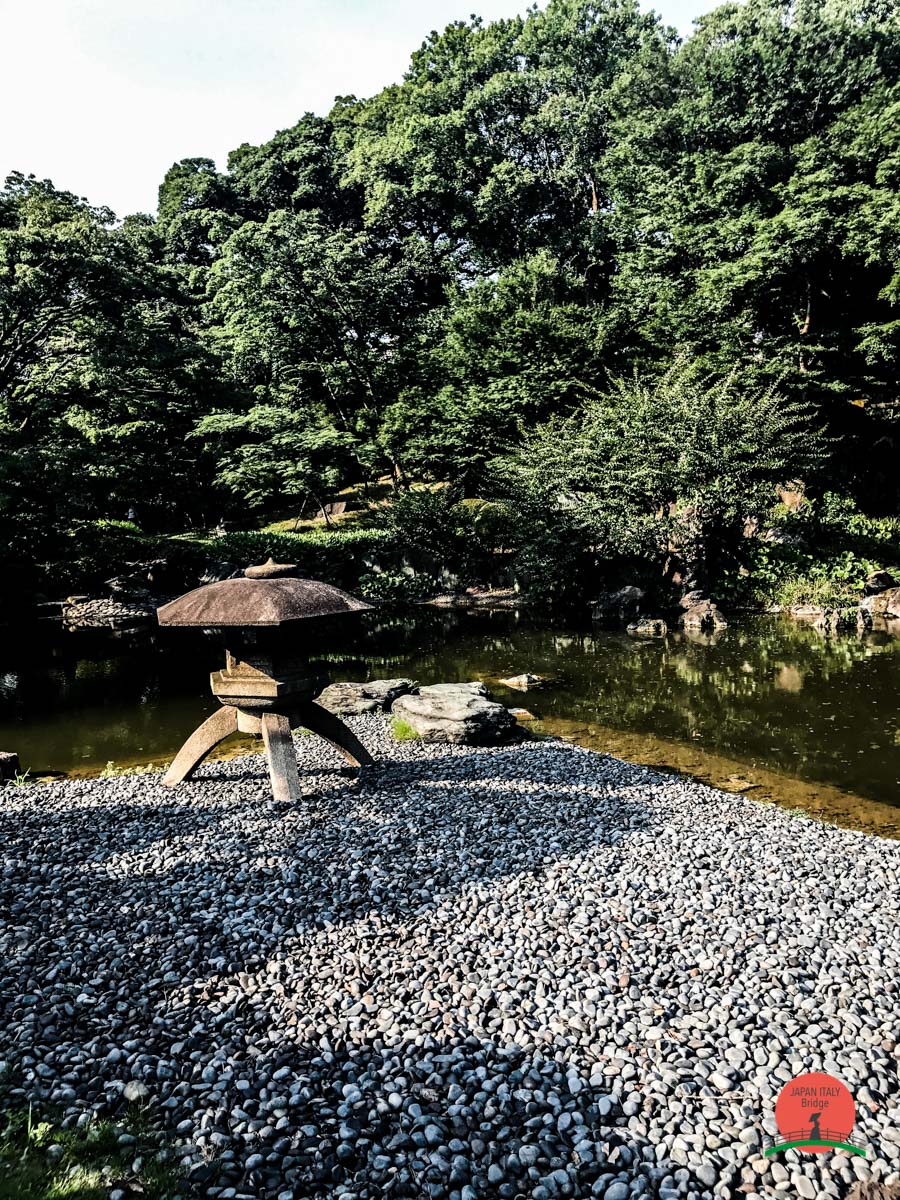
Kitanomaru
Situato nella parte settentrionale del castello di Edo, questo parco pubblico è famoso per essere la casa del Nippon Budokan Hall, uno dei più grandi siti per concerti, eventi sportivi e altro ancora.
Qui potete anche trovare un monumento in bronzo dedicato al principe Kitashirakawa Yoshihisa (親王白川宮能久親王 Kitashirakawa-no-miya Yoshihisa-shinnō)
East Garden
Ultimo ma non meno importante, gli East Gardens, i più famosi di questo complesso. Qui si trova la maggior parte degli edifici amministrativi del palazzo e comprende le ex zone di Honaro e Ninomaru del castello di Edo, per un totale di 210.000 m2. Situato sul terreno dell'East Garden troviamo l’Imperial Tokagakudo Music Hall, il Music Department of the Board of Ceremonies of the Imperial Household, Archives and Mausolea Department Imperial Household Agency, strutture per le guardie come il dojo Saineikan e il Museo delle collezioni imperiali.
I lavori di costruzione iniziarono nel 1961 con un nuovo laghetto nel Ninomaru, così come la riparazione e il restauro di vari edifici e strutture del periodo Edo. Il 30 maggio 1963, l'area fu dichiarata dal governo giapponese una "reliquia storica speciale" ai sensi della legge sulla protezione delle proprietà culturali.


Questo è in realtà il mio preferito e ogni volta che vengo a Tokyo, cerco sempre di passare un pomeriggio qui. È uno dei posti più visitati della città, è vero, ma nonostante tutti i turisti che passeggiano, c'è questa magica atmosfera di tranquillità nell'aria ed è il posto perfetto per sedersi, leggere un libro, scrivere sul vostro quaderno tutte le avventure che avete avuto in questa incredibile città e assaporare tutta la storia che questo luogo ha vissuto.
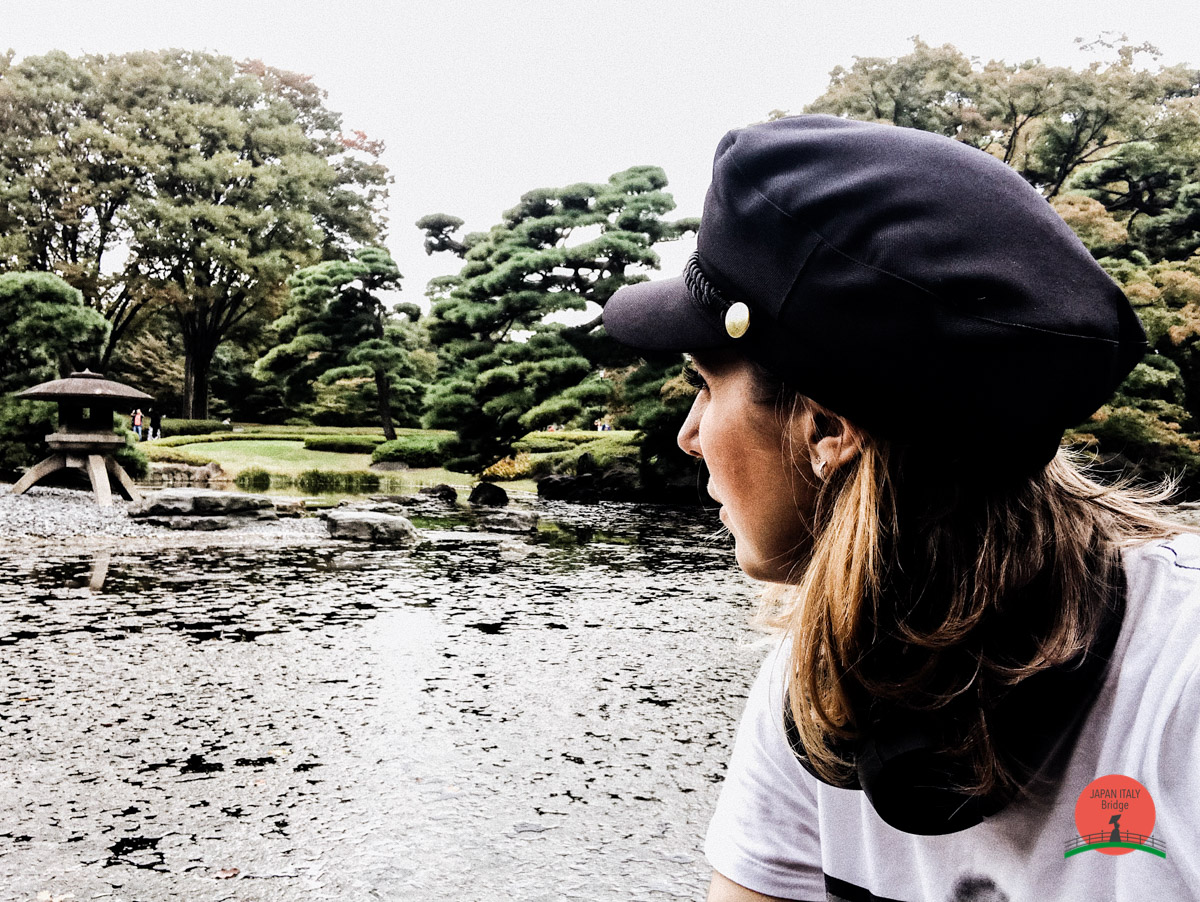
Accesso
L'ingresso di Otemon agli East Gardens è a pochi passi dalla stazione di Otemachi sulle linee Chiyoda, Tozai, Marunouchi, Hanzomon e Mita. Può anche essere raggiunto in 10-15 minuti a piedi dalla stazione di Tokyo.
Orari di apertura
Dalle 9:00 alle 16:30 (fino alle 17:00 da metà aprile ad agosto, fino alle 16:00 da novembre a febbraio). L'ammissione termina 30 minuti prima della chiusura.
Chiuso
Il lunedì, il venerdì, il nuovo anno (dal 28 dicembre al 3 gennaio) e alcune occasioni speciali. Se il lunedì o il venerdì è una festa nazionale, i giardini sono chiusi il giorno successivo.
Ammissione
Gratuita
Japan Modern Culture: Apre il Nuovo Tsukiji Fish Market e si chiama Toyosu Market
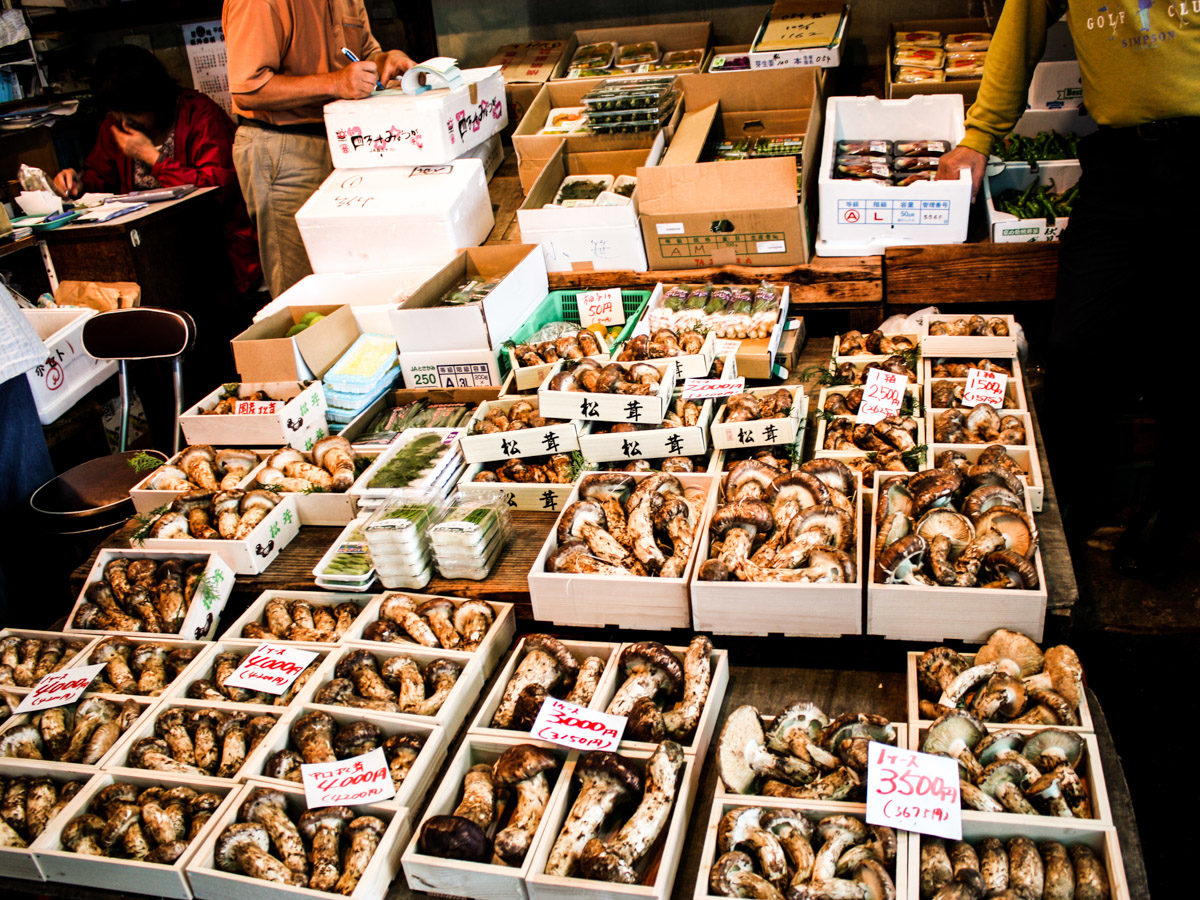
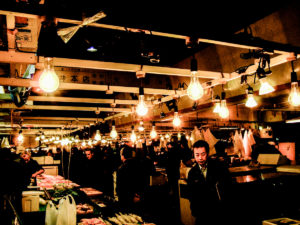
photo credit: nika-88 on flickr & karipkarip on flickr
Tutti gli appassionati del Giappone hanno sentito parlare almeno una volta dello Tsukiji Fish Market. Il mercato ittico all'ingrosso di Tsukiji (in giapponese 築地市場, Tsukiji shijō) è stato il più grande mercato del pesce del mondo. Si trovava a Tokyo, nel distretto di Tsukiji, spostato nella zona Toyosu lo scorso ottobre.
Visitato ogni anno da migliaia di turisti, l’odierno Toyosu (Tsukiji) Fish Market ospita un numero di lavoratori che oscilla da 60.000 a 65.000 unità, tra venditori accreditati, personale amministrativo e operai.
Lo Tsukiji Fish Market era, ed è tutt’oggi, una vetrina su un importante elemento della cultura gastronomica giapponese e dell’economia della nazione. Considerato un’istituzione nazionale, da ottobre finalmente ha stabilito le radici nel nuovo spazio di Toyosu, mandando in pensione dopo oltre 80 anni lo spazio nel quartiere Tsukiji. Il mercato del pesce di Tokyo continua a mantenere il suo record come il più grande mercato ittico all'ingrosso del mondo.
Lo Tsukiji Fish Market è sempre stato uno dei simboli della relazione simbiotica fra la cucina giapponese e l’oceano. Non è infatti raro trovare chef internazionali e ristoratori di tutta la città camminare fra le aste ogni mattina e rimanere stregati dall’atmosfera di questo posto.
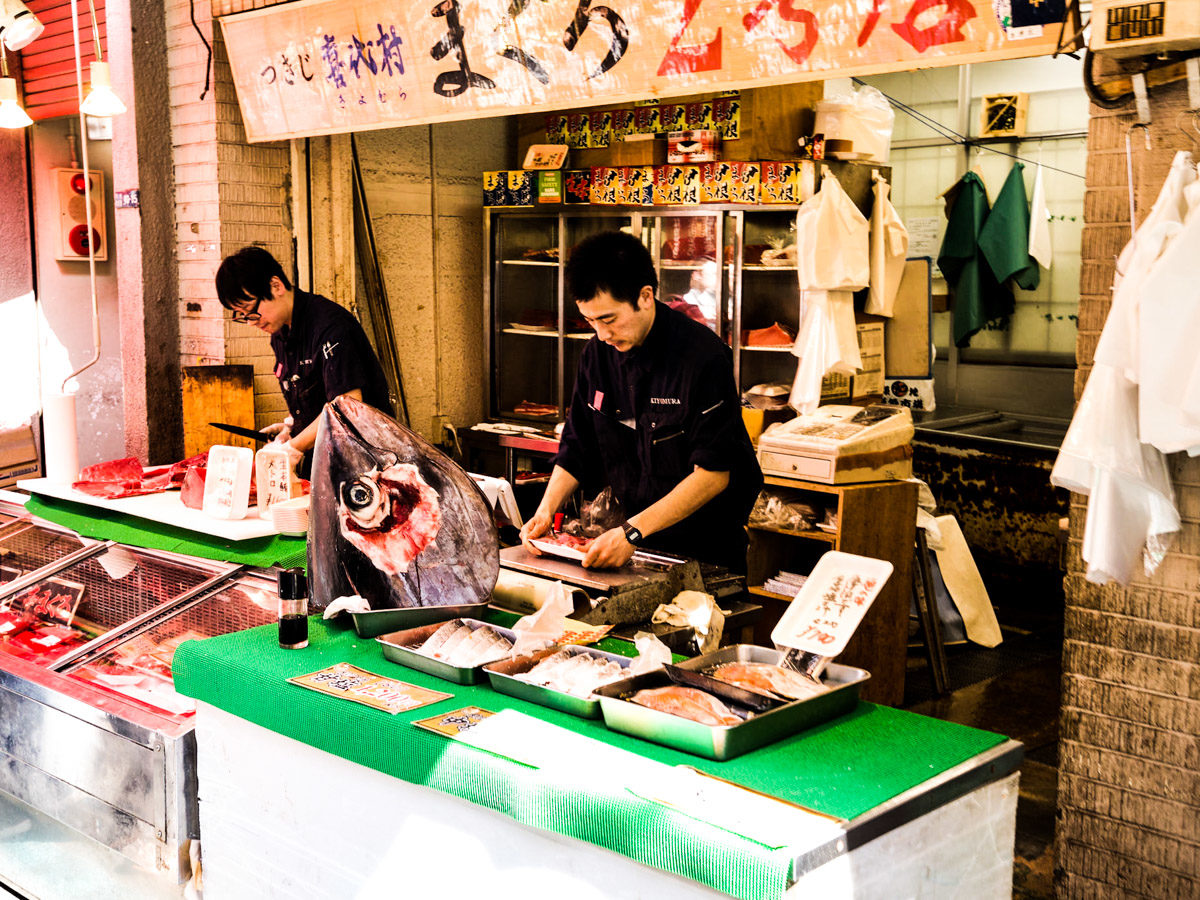
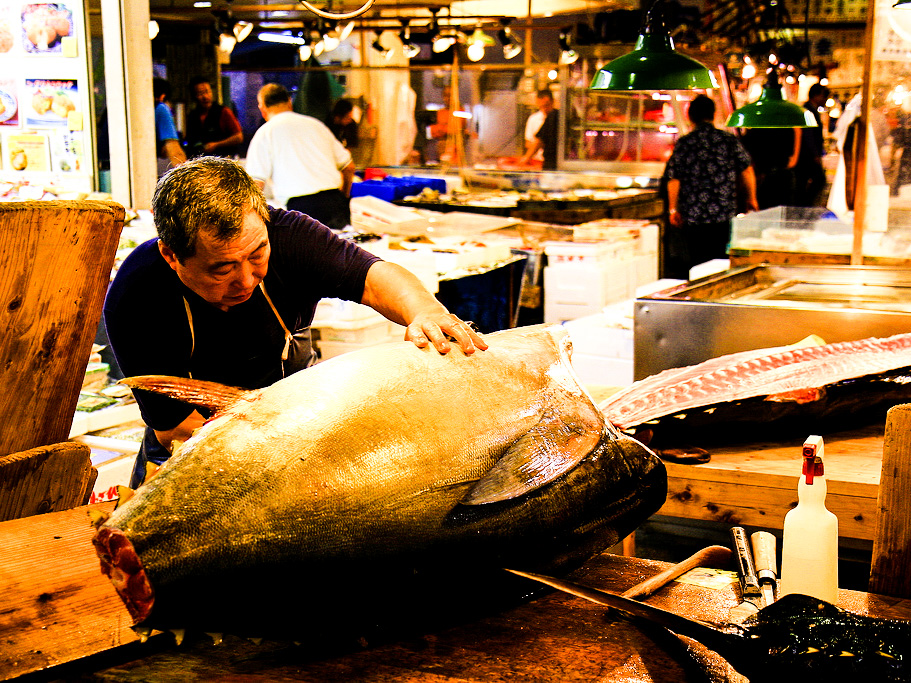
photo credit: yuichi38 on flickr & 584laurel on flickr
La Storia
La storia dello Tsukiji è egualmente impressionante. Oltre 500 specie di pesce vendute quotidianamente, inclusi alcuni tagli di sushi veramente costosi, 700 mila tonnellate di prodotto venduto ogni anno, più di 12 milioni di euro in turnover quotidiano.
Già in sostituzione del precedente mercato nell’area di Nihonbashi distrutto dal Grande terremoto di Kanto nel 1923, lo Tsukiji fish market ha aperto le sue parte nel 1935. Con le sue centinaia di bancarelle, il mercato è famoso per la vendita di pesce che varia dagli scampi alla balena, ma soprattutto per la quotidiana asta dei tonni pinna blu, venduti per migliaia di dollari l’uno. Una tradizione che continua anche nel nuovo mercato di Toyosu è anche quella dell’asta di capodanno dove i ristoratori competono l’uno contro l’altro per pagare il prezzo più alto per il primo tonno del 1 gennaio di ogni anno.


photo credit: jpellgen on flickr & thisisinsider.com
Il mercato apre alle 5 del mattino ed è frequentatissimo anche dai turisti. Se volete approfittare del vostro jet lag, assicuratevi di mettervi in coda per essere selezionati nel ristretto gruppo di visitatori a cui è permesso guardare l’asta dei tonni.
I tonni appaiono in varie pezzature e, durate l’asta, sono posti a terra, in ordine, ancora surgelati. Ogni taglio è munito di cartellino che ne indica peso, qualità e provenienza, e si presenta senza testa e con le code tagliate in modo da poter visionare il colore della carne.
Ad asta finita, tutti i visitatori possono mettersi in code ancora più lunghe per vedere gli addetti ai lavori che procedono al sezionamento e alla preparazione delle trance di tonno già pronte all’uso. E’ qui che si potrà vedere e assaggiare il classico taglio per il sushi e lo sashimi più buono che voi possiate assaggiare.

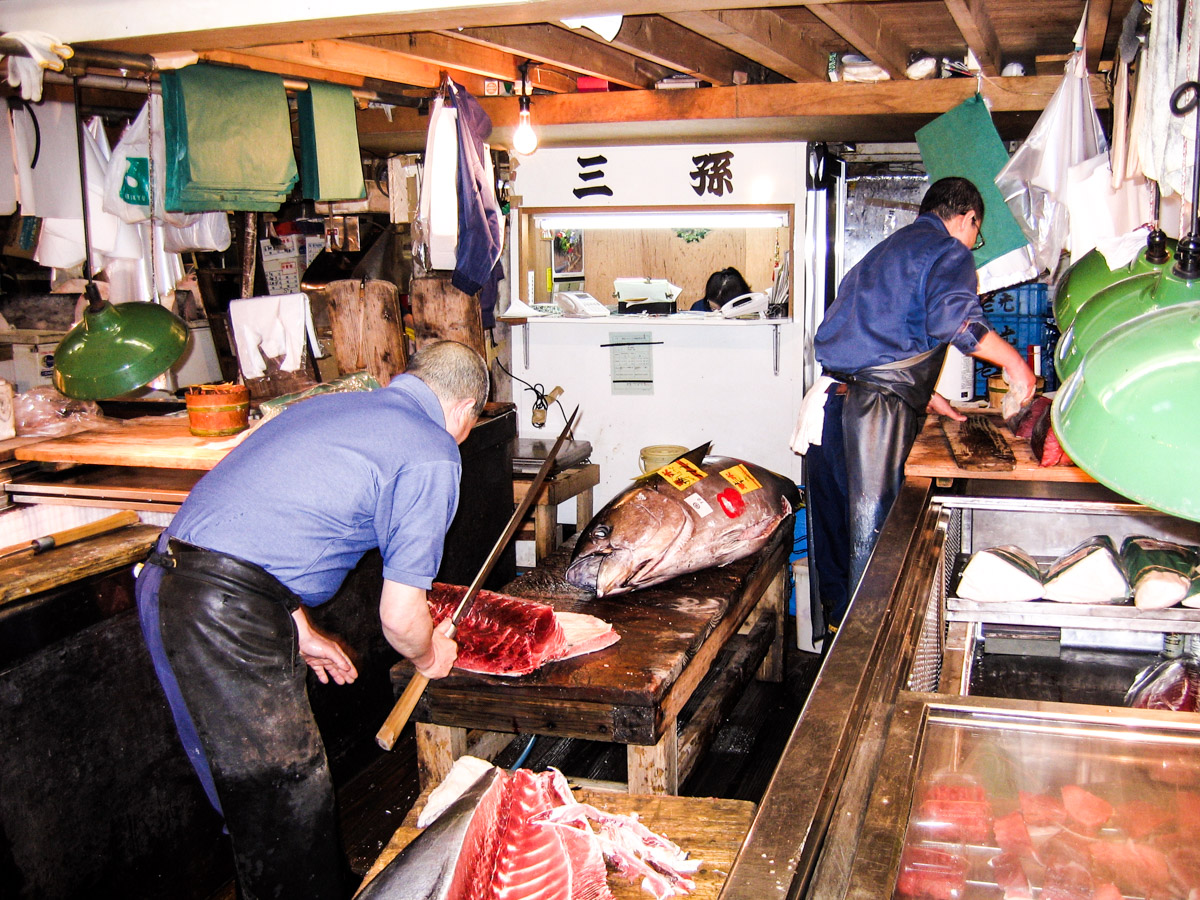
photo credit: thisisinsider.com & jpellgen on flickr
Dov’è lo Toyosu Fish Market ora?
Il Nuovo Tsukiji Fish market, ora rinominato Toyosu Fish Market, si trova vicino alla stazione di Shijomae sulla Linea Yurikamome, nel quartiere Koto di Tokyo, circa 2 km ad est di Tsukiji. E’ ospitato in 3 edifici interconnessi (due per la vendita del pesce e uno per la vendita di frutta e verdura). Gli edifici sono connessi direttamente alla stazione con un passaggio sopraelevato coperto, rendendolo perfetto per ogni clima. Toyosu è grande quasi il doppio del vecchio Tsukiji market, circa 40.7ha che gli permette di mantenere il suo status come mercato ittico più grande al mondo


photo credit: CNN.com & thisisinsider.com
Ammissione al Toyosu Fish Market
L’entrata al Toyosu Fish Market è gratuita e potete guardare le aste dalle piattaforme dedicate. Vi basterà avere un pass visitatori per entrare negli edifici e poter anche assaggiare tutti i deliziosi manicaretti nel compresso dei ristoranti, la maggior parte dei quali è stata trapiantata dal vecchio Tsukiji.
In quest’area in realtà non c’è molto altro, ma se volete rimanere in zona, potete andare ad esplorare la vicina Odaiba. Inoltre si dice che nel 2022 verrà aperta la Senkyaku Banrai, una strada dedicata allo shopping parte integrante di un progetto per rendere la comunità più vivibile e vivace.


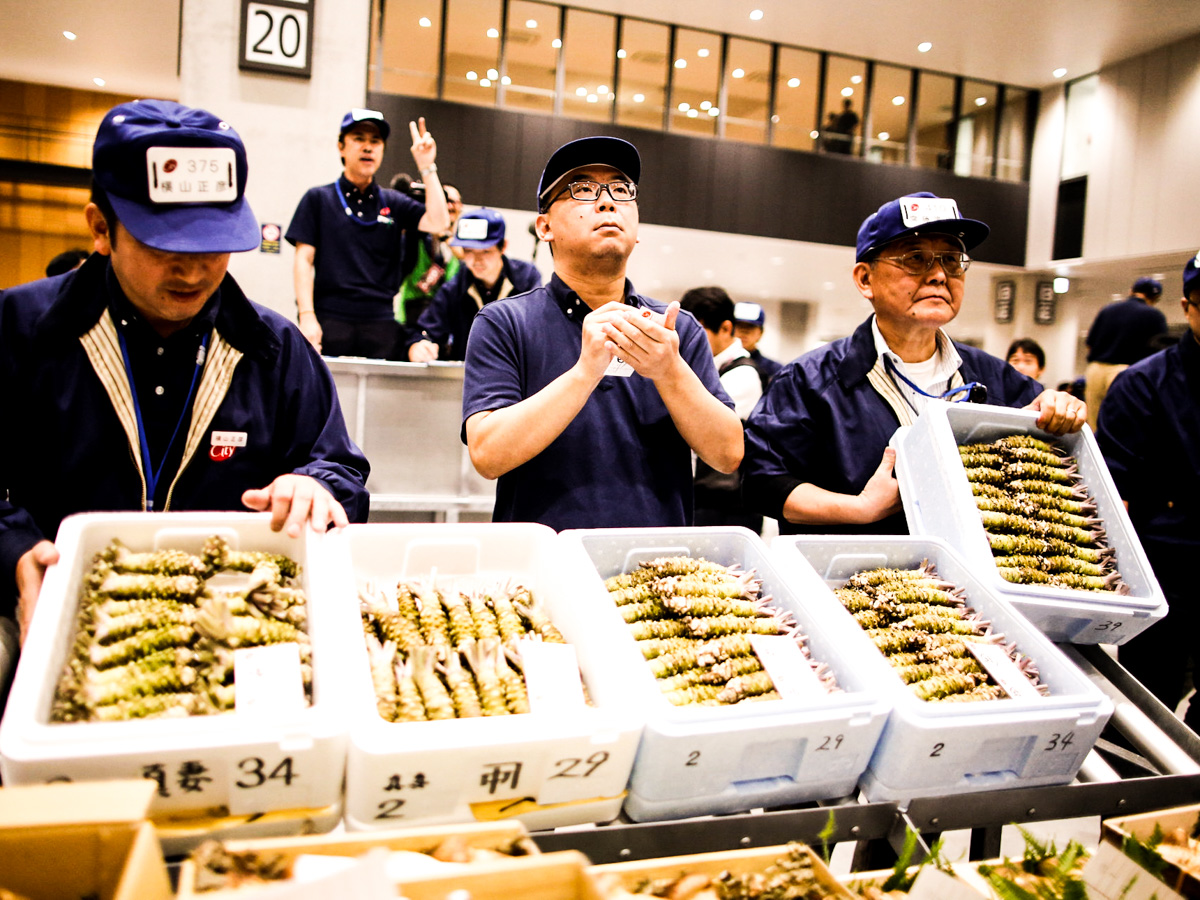
photo credit: falloutx & thisisinsider.com
Japan Travel: Pianificare un viaggio in Giappone
Paese di contrasti e contraddizioni, il Giappone è una delle destinazioni di viaggio più ambite al mondo. Anche tra i paesi asiatici, il Giappone ha una propria cultura ed è unica rispetto alle altre nazioni della regione. Storia e tradizione convivono insieme alla modernizzazione e ai progressi compiuti nel secolo scorso. È questa impeccabile convivenza che dà a questa nazione uno scenario unico e diverso dalla tipica civiltà occidentale. Questo è l'unico posto in cui è possibile vedere antichi templi e santuari, geishe e vecchie case da tè situate accanto al famoso treno proiettile e ai robot.


Il Giappone è un paese relativamente piccolo rispetto ad altri paesi, quindi è molto facile viaggiare da nord a sud. Ogni città ha il suo carattere e la sua atmosfera che scoprirete sia esplorando solo i punti salienti sia immergendosi profondamente nella cultura.
Tuttavia, se state pianificando il vostro primo viaggio in Giappone potrebbe essere un compito difficile. Quindi, in questo post, condivideremo alcuni suggerimenti che potrebbero rivelarsi utili quando desiderate iniziare la vostra avventura giapponese.
Quando visitare il Giappone
Se amate il Giappone, potreste visitare il paese durante una delle stagioni più significative dell'anno per i locali. Hanami (osservazione dei fiori di ciliegio, seconda metà di marzo fino a maggio) è ampiamente conosciuta come una delle stagioni più belle per visitare il Giappone. E nonostante i costi elevati durante questo periodo, è ancora la stagione più popolare per visitare il paese.
Se decidete di visitare il Giappone e la sua capitale durante l'estate, preparatevi al caldo, all'umidità e preparatevi a sudare. Le estati in Giappone, specialmente nelle regioni centrali e meridionali, sono note per essere molto calde e umide. Il tempo è comunque piacevole per la maggior parte dei giorni.
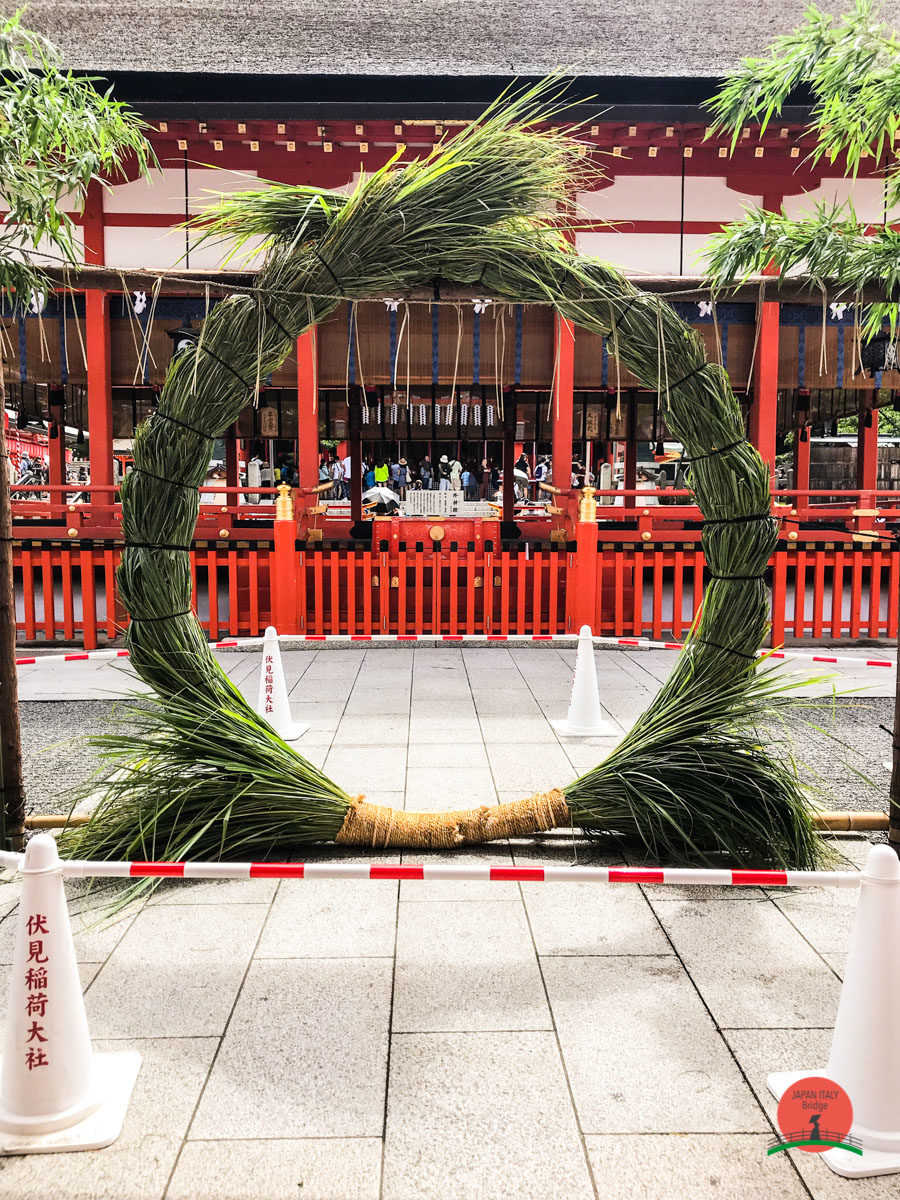

La stagione autunnale in Giappone è un altro periodo meraviglioso per uno splendido scenario, con il fogliame autunnale che trasforma i verdi estivi in rossi infuocati. Il tempo sarà per lo più fresco e più secco dell'estate.
Oltre a questi, è sempre possibile visitare durante le festività natalizie tra Natale e Capodanno. Ogni anno, le città si illuminano di luminarie festive per creare un'atmosfera magica e mistica. Va da sé che questi sono meglio vissuti di notte. Il tempo durante queste settimane non è in genere troppo freddo, ma potrebbe esserci neve a seconda della regione che si visita, quindi assicuratevi di mettere in valigia vestiti caldi.
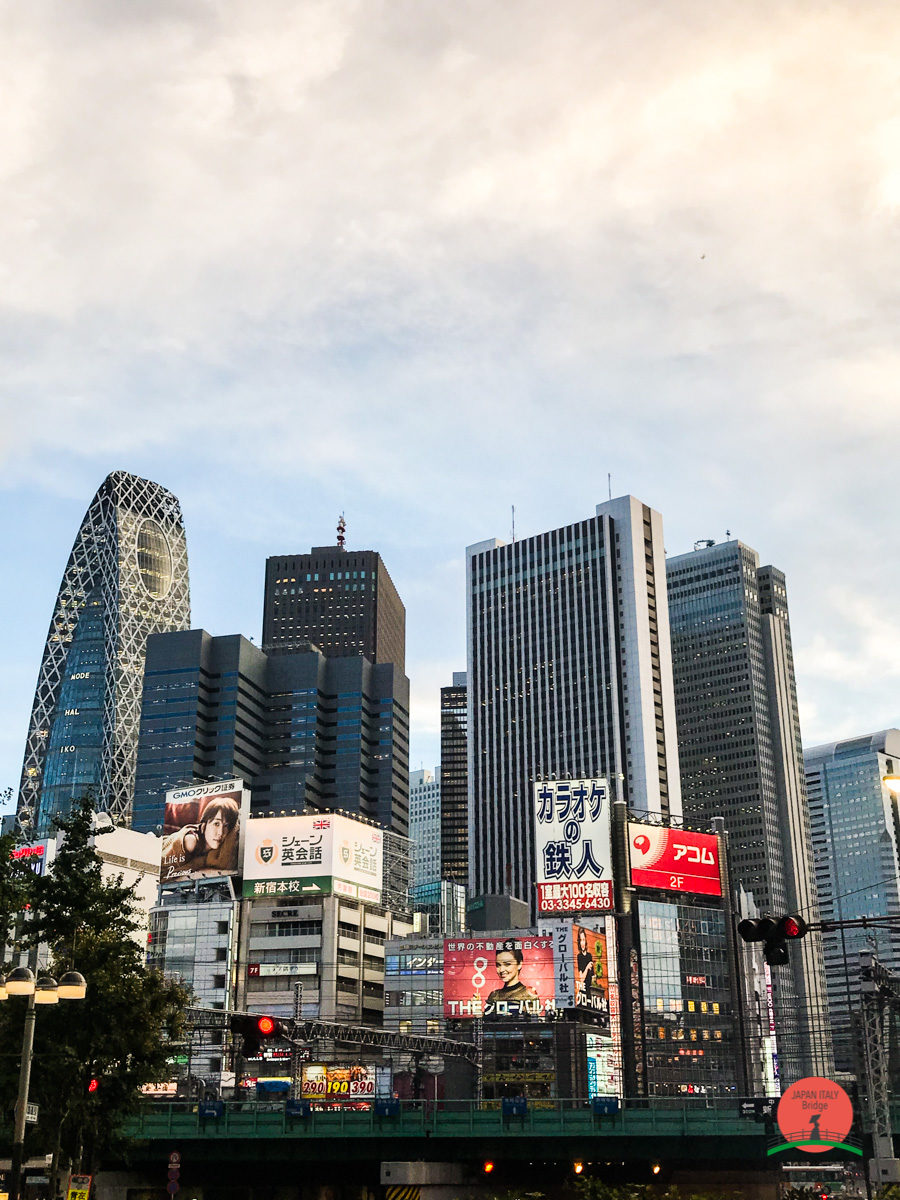
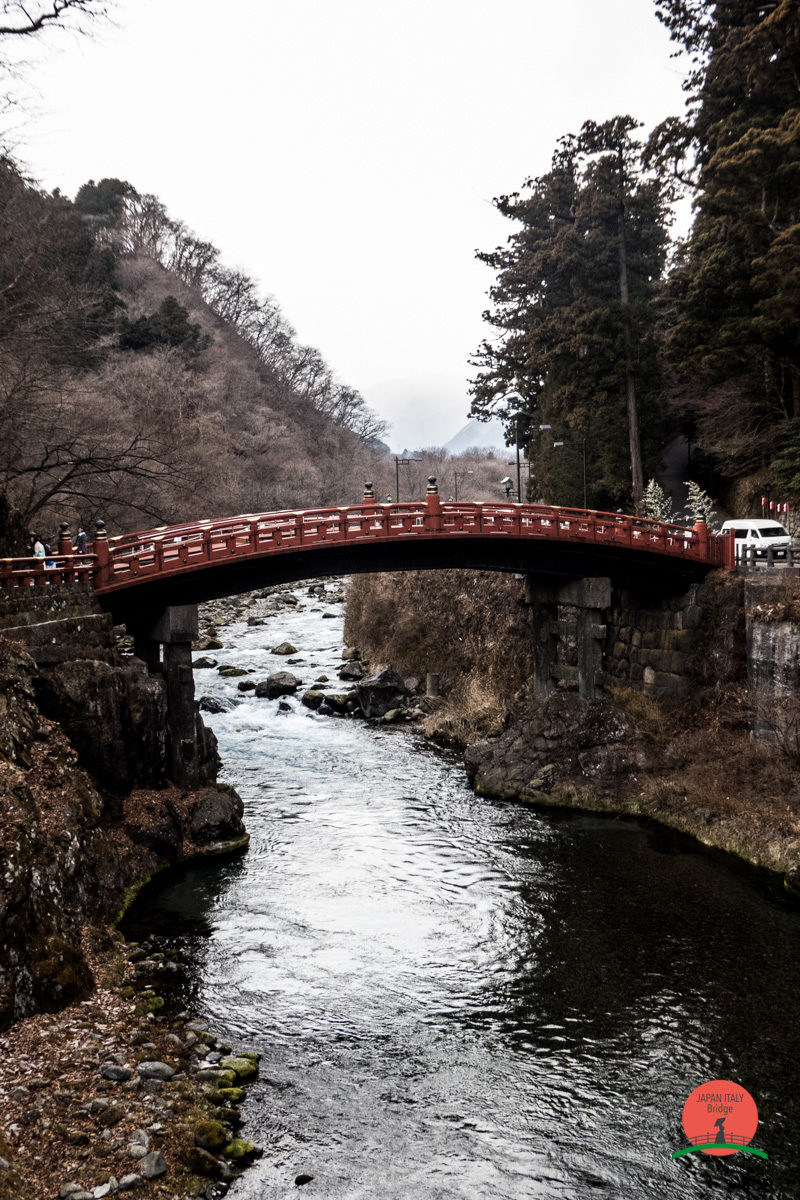
Quanto stare in Giappone
Anche se il Giappone sembra piccolo sulla mappa del mondo, la vibrante cultura di questo paese è piena di cose e esperienze uniche. Visitare l'intero paese in una volta sola sarà un viaggio piuttosto costoso. Quindi, se avete intenzione di rimanere per più di due settimane in questo posto fantastico, assicuratevi di pianificare la spesa e di assegnare la giusta quantità di denaro per ogni giorno
Quali città visitare
Indipendentemente dal tempo in Giappone, questi posti dovrebbero essere nella vostra lista dei must-go. Di solito i percorsi sono gli stessi per ogni viaggio. Quindi, ecco i nostri suggerimenti per viaggiare se desideri limitarti alle principali città del Giappone
1. Tokyo
2. Nikko
3. Takayama
4. Hiroshima
5. Kyoto
6. Osaka
7. Nagoya
8. Yokohama
9. Niigata
10. Sendai
11. Sapporo
Scegliendo una di queste città come base, avrete accesso a gite di un giorno/paio di giorni nelle città e cittadine limitrofe. Notate che sebbene le grandi città siano pubblicizzate come i punti salienti del Giappone, le destinazioni meno conosciute del paese sono piene di tesori nascosti che potete scoprire.
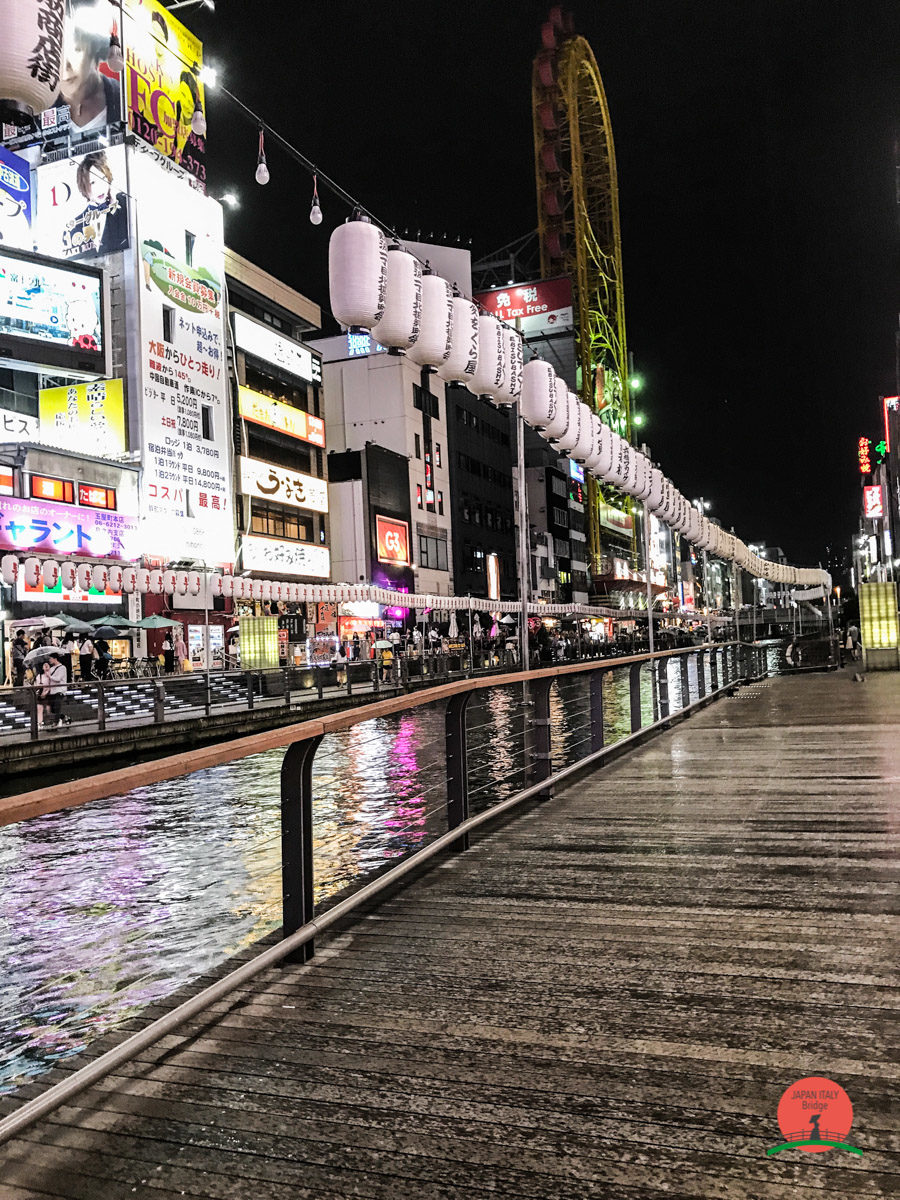

Budget
Il Giappone ha la sfortunata reputazione di essere un paese costoso. Anche se questo può essere vero, in realtà non è molto diverso da qualsiasi altro paese come l'Italia o l'Inghilterra.
Potete adattare il budget del vostro viaggio in base alle vostre preferenze e a quello che avete, e ci sono molti modi per risparmiare denaro. Potete trovare diverse combinazioni di offerte che includono sia voli che alloggi online su siti Web.
Transportation
Quando si vola a Tokyo, la capitale del Giappone, si atterra all'aeroporto Narita o di Haneda. Il Giappone ha una meravigliosa rete di trasporti che è molto estesa e affidabile. Esistono diverse app che possono aiutarvi a trovare i percorsi da utilizzare. Per i treni e i trasporti pubblici, le app di go-to sono HYPERDIA e JR-EAST Train Info.
In ogni stazione, ci sono distributori di biglietti, ma in caso di dubbio, si può sempre chiedere ai membri dello staff ai banchi informazioni della stazione. Di solito c’è qualcuno che parla inglese di base.

Cards & Passes
L'acquisto di biglietti presso i distributori automatici a volte può rivelarsi problematico, soprattutto se non si legge la lingua. Per semplificare le cose, ci sono diverse carte che puoi usare. Le informazioni sulle varie carte e pass sono le seguenti:
- Japan Rail pass: è un pass per il sistema ferroviario che è possibile utilizzare su tutta la linea ferroviaria JR, la compagnia nazionale di trasporto ferroviario. Puoi acquistare il pass solo dall'estero, quindi devi acquistarlo mentre sei ancora nel tuo paese. Il pass ha 7, 14 o 21 giorni consecutivi di validità. È possibile acquistare la prima classe (verde) o la seconda classe (ordinaria). Lo standard di qualità sui treni giapponesi è molto alto, quindi anche se acquisti il pass di seconda classe puoi comunque viaggiare molto comodamente. Inoltre, c'è uno sconto del 50% per i bambini tra i 6 e gli 11 anni.


- Suica Card: questa è una carta prepagata. Può essere usata al posto dei biglietti del treno, ma anche come normale carta prepagata in alcuni negozi. La carta Suica è valida in tutto il Giappone, offre anche un piccolo sconto sulla metropolitana di Tokyo ed è molto comoda perché permetterà di evitare di passare attraverso il processo di biglietteria ogni volta che si vuol salire sul treno. Si può comprare e ricaricare in biglietteria in ogni stazione attraverso i distributori automatici o rivolgendosi ad un agente di biglietteria.
La Suica Card è valida sui treni appartenenti alle linee JR East e sui treni JR delle seguenti regioni: Sendai, Niigata, Sapporo, Osaka, Okayama, Hiroshima, Nagoya Shizuoka. È anche possibile utilizzarla su alcuni treni, autobus e metropolitane nella regione di Fukuoka.
Sulla Suica puoi ricaricare fino a 20000 ¥. Il costo iniziale per acquistare la carta può essere 1000, 2000, 3000, 4000, 5000 e 10000 ¥ e questo include il deposito di 500 ¥.
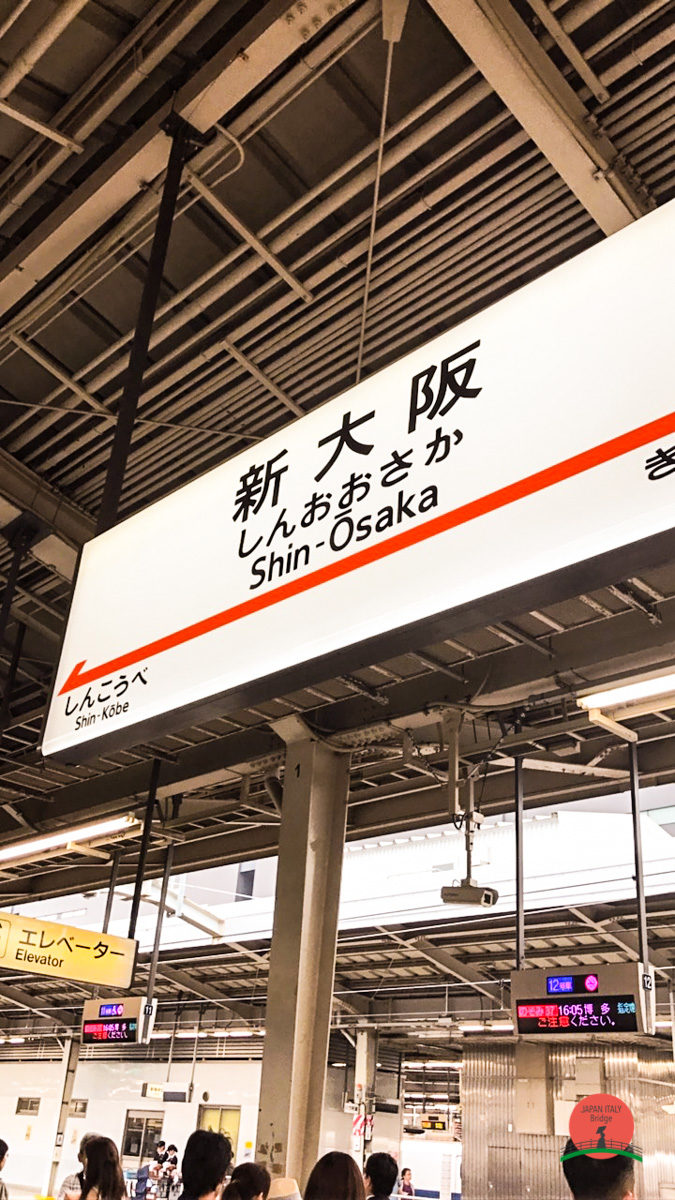

Per usare la Suica, si appoggia la carta sul sensore blu alle barriere della metropolitana / treno. Se il sensore rimane blu, le porte delle barriere si aprono e si può passare. Se il sensore diventa rosso, significa che il credito sulla carta non è sufficiente e si deve ricaricare. Può valere la pena notare che queste carte e gli importi addebitati rimangono validi fino a 10 anni dalla tua ultima corsa.
- Pasmo: questa è una carta per il trasporto di Tokyo e funziona esattamente come la Suica.
Hotels in Japan
Alberghi e alloggi sono in genere la parte più costosa di un viaggio in Giappone. Tuttavia, una gamma molto ampia di tipi di alloggio è disponibile sia con interni in stile giapponese che in stile occidentale. I prezzi per notte possono variare da meno di 2.000 yen a persona in un dormitorio o in un hotel a capsule a oltre 50.000 yen a persona in un Hotel di prima classe o Ryokan.
I ryokani (e le loro versioni più economiche, i minshuku) sono tradizionali pensioni giapponesi e sono i luoghi migliori per conoscere le tradizioni culturali relative al cibo e all'ospitalità giapponesi. Questo è qualcosa di unico che può essere vissuto solo in Giappone. In quanto tale, se il budget lo consente, si può pianificare di rimanere in uno di questi luoghi per un paio di notti. Il Giappone ha anche capsule, o pod, alberghi in cui essenzialmente dormi in una versione high-tech di letti a castello.


Cibo Giapponese
La cucina giapponese è una delle migliori al mondo, offre una dieta equilibrata in una vasta gamma di delizie gastronomiche e piatti stagionali. Ristoranti sono facilmente reperibili, dai ristoranti di fama mondiale, con stelle Michelin ai locali stand-in-the-wall che sono popolari tra la gente del posto. Sebbene il sushi e il sashimi siano i più famosi piatti giapponesi conosciuti in tutto il mondo, il Giappone ha in realtà una così grande varietà di cibi che c'è davvero qualcosa da mangiare per tutti. Molti dei migliori locali sono, tuttavia, tipicamente specializzati in un tipo di cibo.
Sushi, Sashimi, Kaisen Don, Tempura, Katsu Curry, Udon, Soba, Ramen, Yakitori, Takoyaki. Questi sono solo alcuni dei piatti che bisogna assolutamente provare mentre si esplora la terra del Sol Levante.
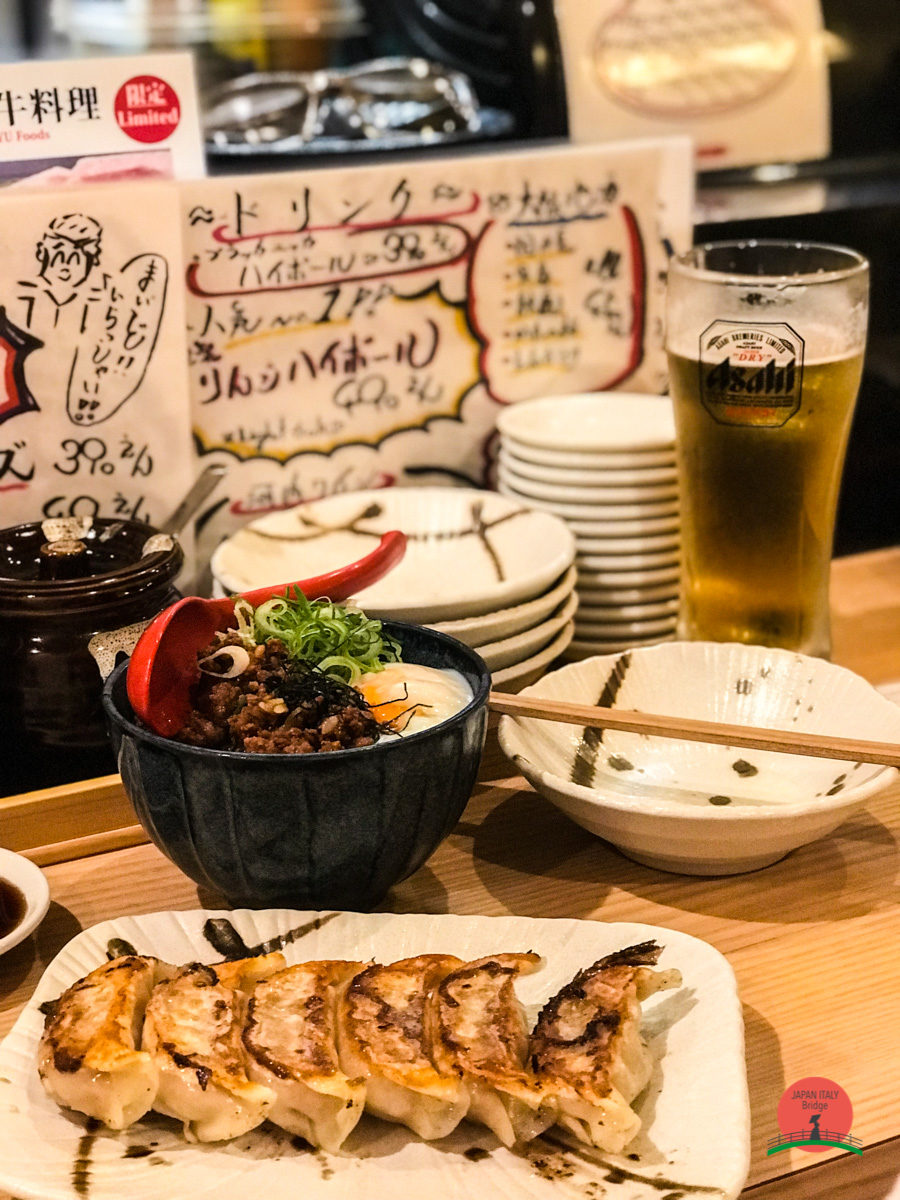

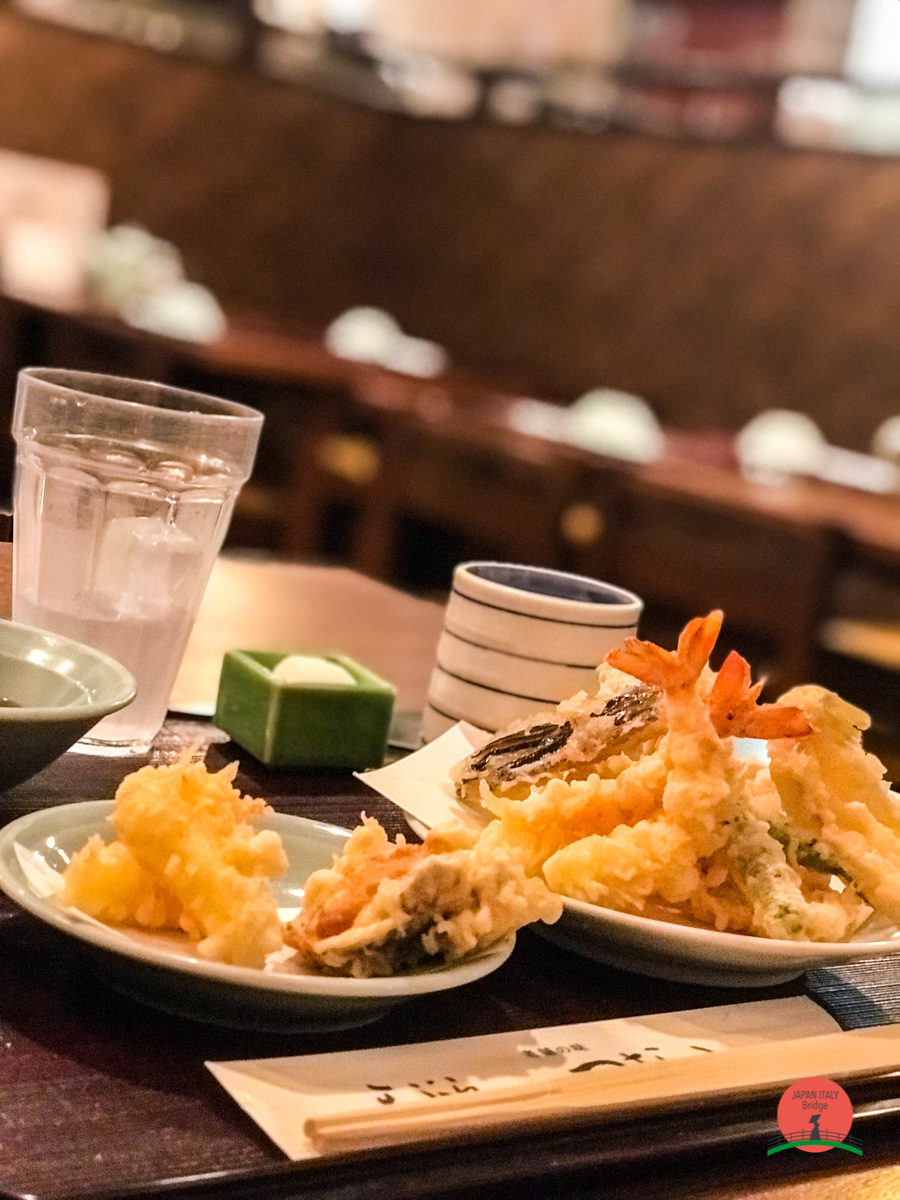
Valigie in Giappone
Indipendentemente dal tempo in cui si pianificare di rimanere nel paese, si deve considerare di avere valigie piuttosto leggere e con poche cose. La maggior parte delle camere degli hotel è molto piccola e a volte potrebbe non esserci spazio sufficiente per avere grandi valigie e molte cose in giro. Avere valigie poco ingombranti è importante se si prevede di viaggiare principalmente con i mezzi pubblici. La maggior parte dei treni non ha spazio per bagagli voluminosi e nonostante il sistema di treni molto avanzato, non tutte le stazioni sono dotate di scale mobili o ascensori. Inoltre, la maggior parte degli hotel non consente di effettuare il check-in prima delle 14:, quindi bisogna prendere in considerazione di trattenere il bagaglio fino a quel momento.

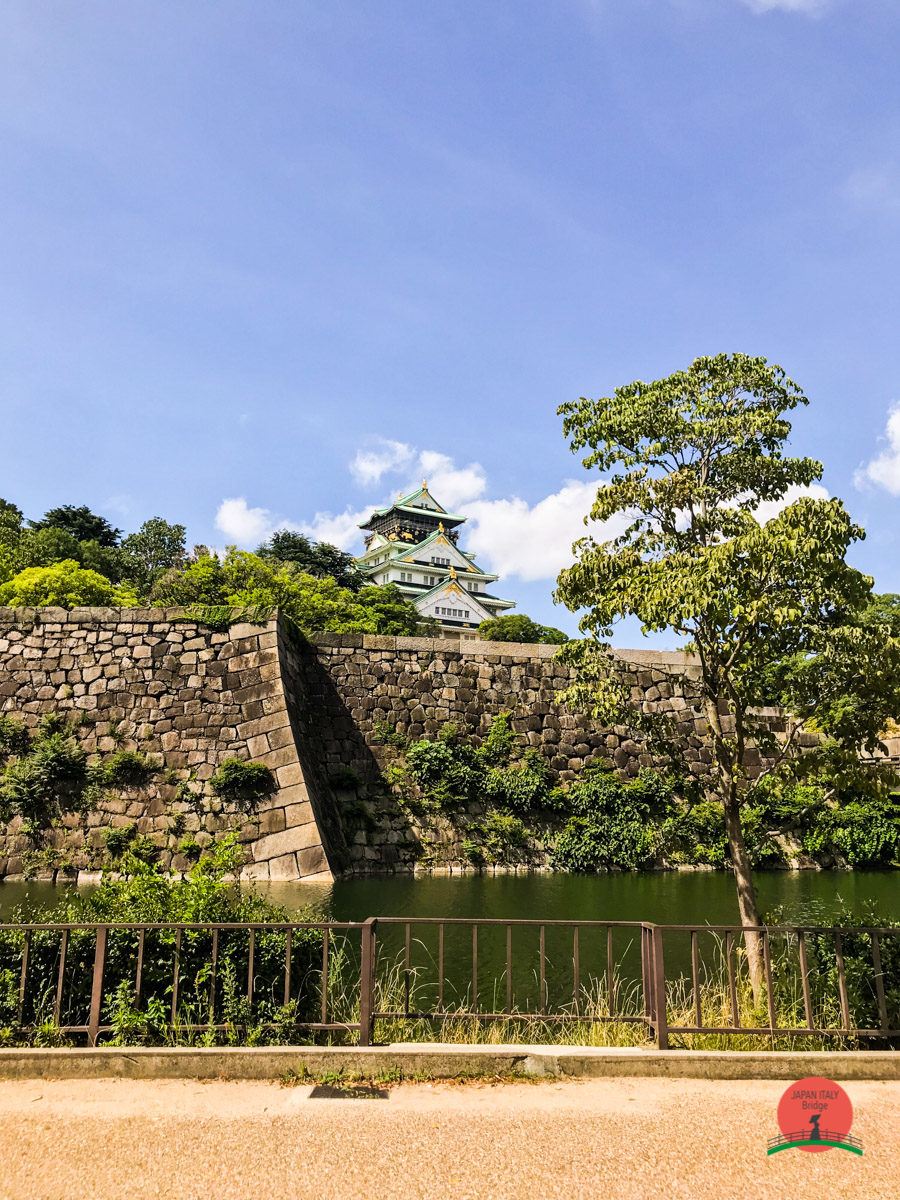
Altre cose da notare
Valuta: Yen giapponese (JPY)
Elettricità: 100 V / 50-60 Hz (spina nordamericana, di solito a due denti, spesso ha entrambi i pin piatti delle stesse dimensioni. Potrebbe essere necessario un adattatore).
Principali aeroporti: Tokyo Narita Airport (NRT). Tokyo Haneda Airport (HND). Aeroporto di Osaka Kansai (KIX).
Acqua: sicura. Porta una bottiglia d'acqua e riempi dal rubinetto mentre viaggi.
Connettività Internet: il Giappone ha un’eccellente connessione internet , uno dei collegamenti più veloci al mondo.
SIM locale/WiFi portatile: è consigliabile comprare una scheda SIM o, meglio, una wifi portatile una volta atterrato. Sebbene non sia economico, è comodo e consente di risparmiare sui piani dati internazionali con le app di comunicazione di oggi. Questo permetterà anche di usare strumenti come Google Maps.
Visti: i cittadini del Nord America, del Regno Unito e dell'Europa non hanno bisogno di un visto per entrare per 90 giorni. Per alcuni di questi paesi sono disponibili estensioni più lunghe. Per la maggior parte degli altri paesi il visto dovrà essere richiesto. Richieste di visto click here .
Festival degni di nota: Hanami, o piuttosto la stagione di visualizzazione dei fiori di ciliegio, è uno dei periodi più popolari per visitare il Giappone (da fine marzo a maggio). Sapporo Snow Festival (febbraio). Fuji Rock Festival (luglio). Golden Week (29 aprile - 5 maggio - è quasi impossibile trovare un alloggio durante questa settimana.)
Sicurezza: il Giappone è incredibilmente sicuro. È nella cultura di ogni cittadino seguire un rigido insieme di regole sociali. I bambini viaggiano da soli, prendono la metropolitana e vanno a scuola da soli senza problemi. Le truffe sono rare. Ci sono alcune segnalazioni di comportamenti sgradevoli degli uomini sui treni, ma tali casi si verificano raramente.

Japan Italy: SPINDLE presenta a Milano - VIDEO
Arriva in Italia Spindle, la più grande ICO giapponese che mira a democratizzare gli investimenti in criptovaluta.
Insieme a TMP Group, abbiamo organizzato un evento dedicato a Milano il 4 giugno per la presentazione di SPINDLE, la più grande ICO giapponese e piattaforma di match-making nata per collegare utenti e cripto hedge fund con equità e trasparenza attraverso la tecnologia Blockchain. Alla presentazione al Talent Garden di via Calabiana hanno partecipato lo Chief Strategy Advisor GACKT, artista di fama mondiale, e Lina Seiche, Senior Analyst e Evangelist di Spindle.
Ecco il video ufficale dell'evento di presentazione tenutosi il 4 giugno 2018 al Talent Garden Calabiana, Milano:
Japan Italy: SPINDLE, la più grande ICO Giapponese e piattaforma match-making, arriva in Italia
Arriva in Italia Spindle, la più grande ICO giapponese che mira a democratizzare gli investimenti in criptovaluta
Come molti di voi sapranno, Japan Italy Bridge è nato dalle menti di Erika Panzeri ed Angela Antenucci e dalla loro esperienza di 6 anni con il mondo giapponese tramite la creazione e la gestione del sito gacktitalia.com.
Insieme a TMP Group, abbiamo organizzato un evento dedicato a Milano il 4 giugno per la presentazione di SPINDLE, la più grande ICO giapponese e piattaforma di match-making nata per collegare utenti e cripto hedge fund con equità e trasparenza attraverso la tecnologia Blockchain. Alla presentazione al Talent Garden di via Calabiana hanno partecipato lo Chief Strategy Advisor GACKT, artista di fama mondiale, e Lina Seiche, Senior Analyst e Evangelist di Spindle.
Spindle è un progetto del Blackstar Group, gruppo fondato da esperti nel campo della finanza, investimenti bancari, legge e tecnologia, con sedi a Shanghai, Londra e Tokyo, con Masamitsu Hirai, CEO di SPINDLE e Bullion Japan Inc. con una carriera come gestore di fondi e consulente per Funai Soken Holdings Inc.
L’obiettivo di Spindle è quello di mettere in discussione sia il concetto di investimento privilegiato, fruibile solo da una ristretta fetta di investitori esperti e di lungo corso, per aprirlo democraticamente a tutti (senza tenere restrizioni di età, origini, o background sociale), sia la mentalità di un'intera struttura finanziaria centralizzata, attraverso lo sviluppo di un enorme ecosistema globale alimentato dalla blockchain.
Qui di seguito tutte le foto ufficiali dell'evento:
Copertura Stampa:
- finanza.tgcom24.mediaset.it
- ilbitcoin.news
- blockchainassociation.it
- finanzaoperativa.com
- blockchain4innovation.it
Japan Travel: Nikkō
Nikkō - La città senza tempo

Poco distante da Tokyo, si trova una città che potremmo definire magica. Questa è Nikkō, letteralmente "La cittа della luce del sole”. Situata nella regione montuosa della prefettura di Tochigi, è una delle più famose mete turistiche del Giappone. Ricca di monumenti storici, è entrata nell’elenco dei Patrimoni dell’umanità dell’UNESCO. I suoi monumenti più famosi sono il Nikkō Tōshō-gū dedicato allo shogun Tokugawa Ieyasu e il Futarasan Jinja risalente al 767.
La città è inoltre immersa nella natura, con montagne, sorgenti termali e il Parco Nazionale di Nikkō dove si possono trovare diverse bellissime cascate.
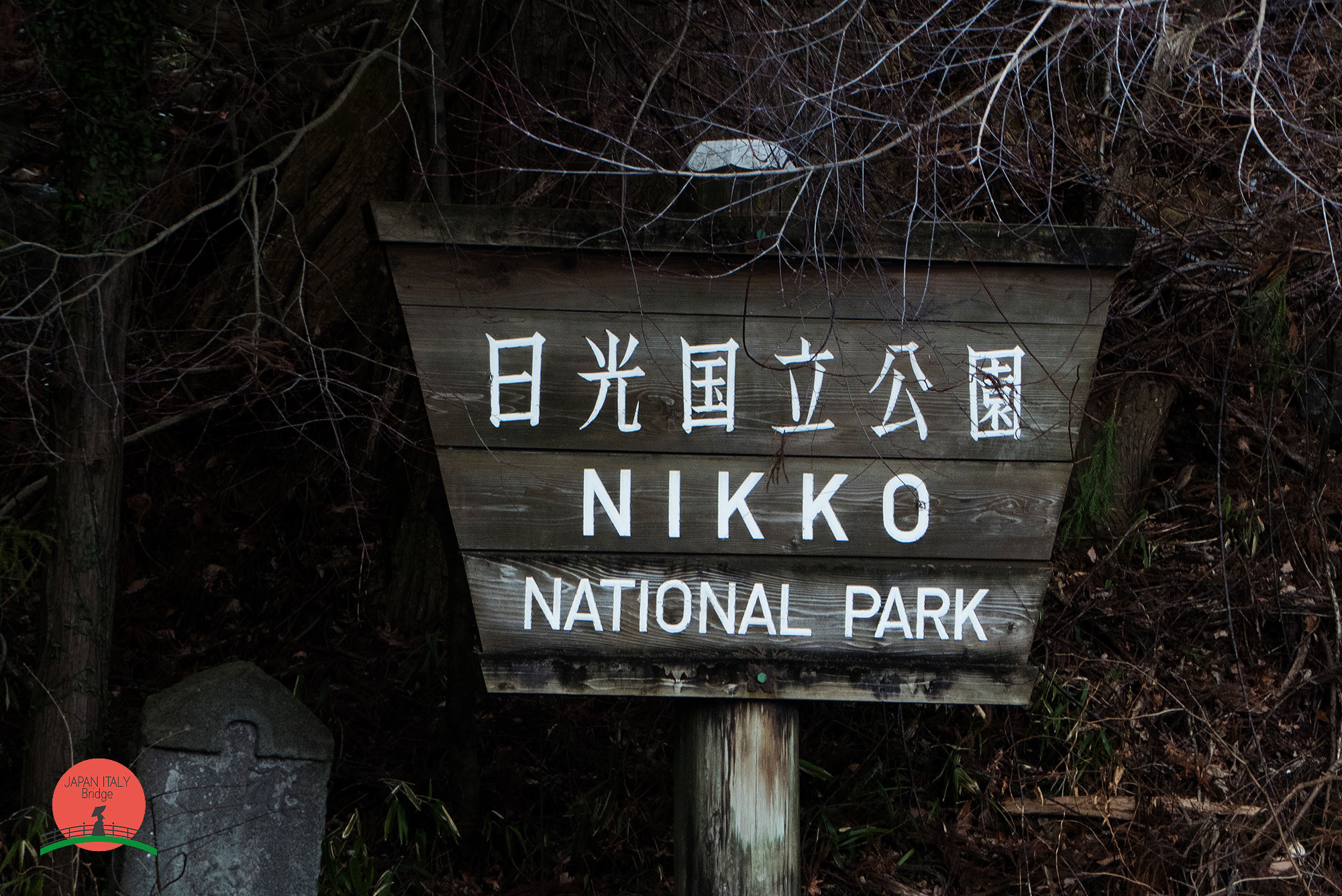
Fra sacro e moderno
Il 20 marzo 2006 la vecchia città di Nikkō si è fusa con la cittа di Imaichi e le municipalità di Ashio, Fujihara e Kuriyama, dando come risultato la nuova città di Nikkō . Sacro e profano, una divisione ancora più marcata dal grande “ponte sacro” Shinkyo, tutto laccato di rosso e originariamente riservato all’imperatore e allo shogun. Oggi questo stesso ponte è percorso da centinaia di visitatori ogni anno per arrivare al Rinno-ji, il grande tempio conosciuto in particolare per la “Sala dai tre Buddha”.
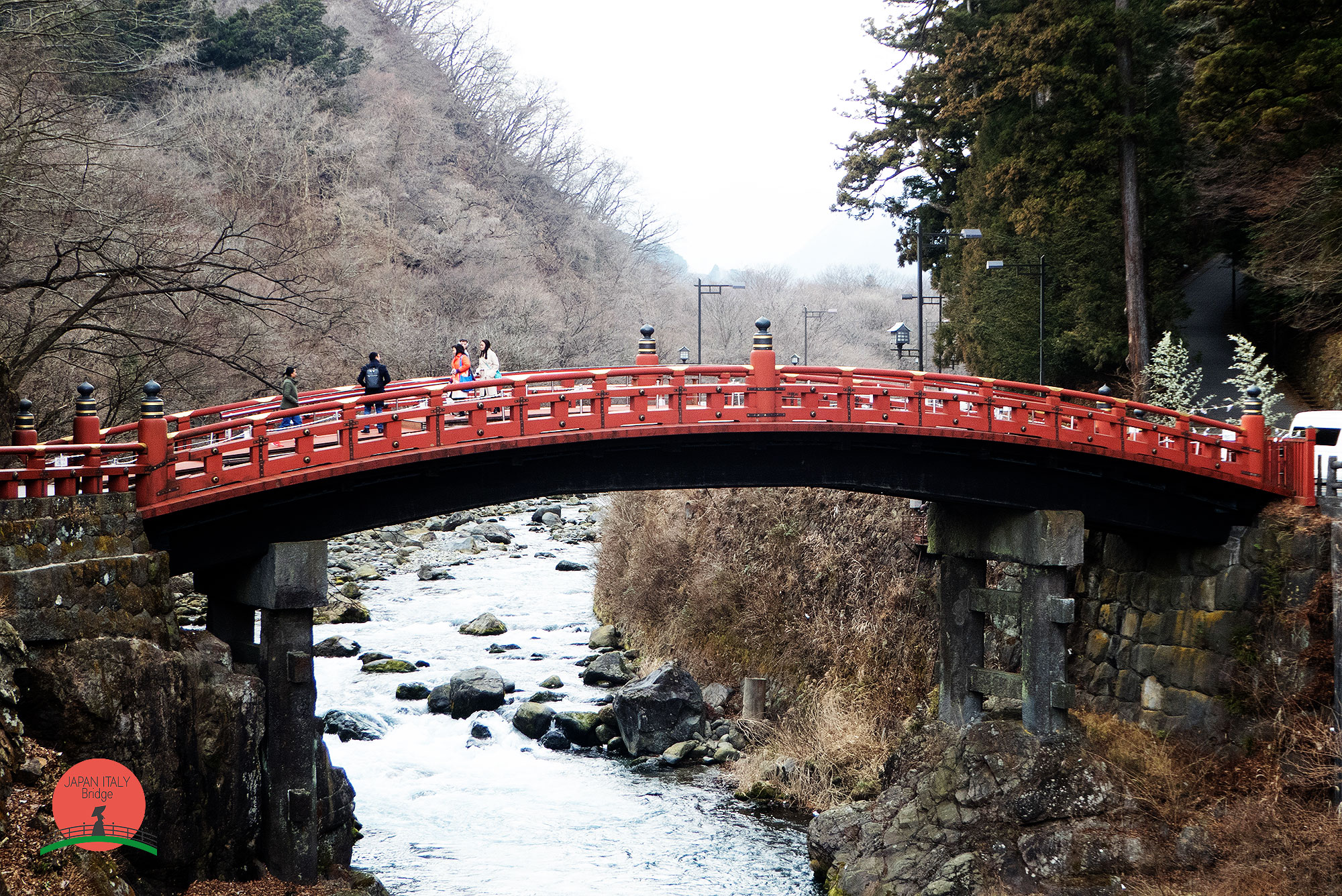
I monumenti
Dietro a questo tempio, si trova il Tōshō-gu, dove la grande famiglia Tokugawa aveva stabilito il suo santuario scintoista, facendolo diventare il più riccamente decorato del paese. Più di 15000 artigiani del paese parteciparono alla sua costruzione e con le sue dorature, i suoi colori brillanti, le sue linee sinuose, questo luogo di culto è considerato tra i più belli dell’architettura Momoyama (1573–1603). Ancora più famoso è il frontone della scuderia sacra, prettamente minimalista e conosciuto da tutti i giapponesi per le tre piccole scimmie scolpite nel legno: Mizaru ("la cieca"), Kikazaru ("la sorda") e Iwazaru ("la muta”). Esse simboleggiano infatti i precetti della setta buddista Tendai, ispirati da Confucio: non guardare il male, non pronunciarlo, non ascoltarlo.

Se avete un’intera giornata per esplorare la città, non potete perdere l’occasione di andare a visitare la statua del gatto addormentato che marca l’entrata alla tomba di Tokugawa Ieyasu. Successivamente, costeggiando il fiume Daiyagawa, potete trovare la passeggiata del Kanmanga Fuchi, una sontuosa camminata fra boschi e strane formazioni vulcaniche del monte Nantai. Alla fine di questa passeggiata, vi aspettano decine di statue di Jizō, protettore dei bambini, dove il tempo sembra essersi fermato.

Ad una distanza di 30 km, potrete poi trovare il magico lago di Chūzenji dove è possibile fare un’escursione in battello per arrivare alla spettacolare cascata Kegon no Taki e alle sorgenti di acqua calda di Yumoto Onsen.
Una città fra la storia e la modernità, fra montagne e laghi incantati, una piccola perla di storia a pochi passi dalla metropoli di Tokyo. Qui si può respirare ancora la classica sensazione della tradizione giapponese nel suo pieno. Una meta assolutamente da non perdere per tutti gli amanti di questa cultura e di questa nazione.
Come arrivare
Il treno è il mezzo più comodo e rapido per raggiungere Nikko dal centro di Tokyo.
Linea Tobu - Asakusa
Dalla stazione di Asakusa, facilmente raggiungibile raggiungibile via metro dai principali quartieri di Tokyo, potete prendere la linea Tobu che offre corse per Nikko ogni ora. Il costo per a/r è di circa 2800¥, il viaggio dura circa 2h ed è in assoluto l'opzione più economica. Il JR Pass non è valido su questa tratta.
info: Website della linea Tobu
Limited express - Shinjuku
Il JR limited express collega direttamente la stazione di Shinjuku con Nikko, il costo del biglietto a/r è di 8000¥. Sfortunatamente, il JR pass non copre completamente la tratta, sarà quindi necessario pagare un sovrapprezzo. Per prenotare la corsa basta consultare i sito della JR east.
Info: Sito di JR East
JR Shinkansen - Tokyo
Questo è il modo più comodo e più veloce per raggiungere Nikko, specialmente se siete in possesso del JR Pass. E’ possibile prendere il JR Tohoku Shinkansen dalla stazione Tokyo, ma dovrete cambiare treno ad Utsunomiya e continuare sulla JR Nikko Line. Il costo della tratta a/r è di 10000¥, sconsigliata per chi non ha il JR Pass.
Info: sito di Hyperdi
SalvaSalva
Japanese Culture: Lolita fashion
Lolita fashion - (ロリータ・ファッション Rorīta fasshon)

photo credit: mangakas-onfire.blogspot.it
Molto probabilmente chi ha una vena molto romantica, sospesa in un tempo indefinito nel passato, vorrebbe apparire come una meravigliosa bambola di porcellana. Magari vorrebbe avere abiti talmente vezzosi da far invidia a Maria Antonietta e partecipare a Tea Party da favola.
Tutto questo è possibile farlo grazie al fenomeno Lolita, una delle più famose ed elaborate mode Giapponesi. Questa è un misto tra Barocco e stile Vittoriano , molto amata in patria ma conosciuta ormai in tutto il mondo.
Il nome evoca ma non celebra il romanzo di Vladimir Vladimirovič Nabokov, ma questa moda non è un tributo ad una giovane e provocante sensualità. Infatti questa rappresenta la bellezza che cela l’ingenuità, l’eleganza nel celare più che nello scoprire. In più, il nome Lolita è un Wasei-eigo, termine che include tutte quelle parole anglofone che in lingua originale hanno un significato completamente diverso o sono addirittura inesistenti, ma sono entrate nel dizionario Giapponese.

photo credit: honoluluacademy.org
Non si sa precisamente quando sia nato questo stile d’abbigliamento. Alcuni sostengono già dalla fine degli anni 70, benché effettivamente è diventato celebre verso la fine degli anni novanta. Questa moda è stata fortemente influenzata dal genere musicale Visual Kei. E non a caso, perchè questo tipo di musica è fortemente teatrale non solo nelle note ma anche nell’abbigliamento delle band stesse.
Esemplari sono i MALICE MIZER anche grazie a Mana co-fondatore e leader della band (chiamato anche Mana-sama dai suoi fans). Mana ha influenzata particolarmente la moda lolita coniando il termine “Gothic Lolita” e firmando il suo personale brand Moi-même-Moitié.

photo credit: pinterest
Gothic Lolita e Sweet Lolita

photo credit: my-lolita-dress.com
Lo stile Lolita e diviso in due correnti ben distinte (a loro volta divise in molteplici sottostili): il Gothic Lolita forse il più celebre, e lo Sweet Lolita.
GothLoli (ゴスロリ gosu rori): Il Gothic Lolita come detto è il genere più conosciuto ma questo nome viene erroneamente attribuito a tutta la moda. Colore dominante è il nero e né si celebrano tutte le più possibili sfumature. Non vengo però disdegnati nemmeno i colori scuri come il rosso bordeaux, il blu scuro, il viola o il verde smeraldo. Questi colori sono spesso utilizzati nelle stoffe come nel make-up con un pesante e drammatico smokey eyes e il rossetto che risalta su una cipria bianca. Di fatto è l’unica eccezione nella moda Lolita dove si utilizza questo tipo di cipria, perché negli altri stili si preferisce un look più naturale. I fitti ricami degli abiti si ispirano a macabri racconti con i loro teschi; o si ispirano a tematiche religiose con croci (appunto gotiche) presenti spesso anche nei gioielli. Bare usate come piccole borse e ombrellini neri di pizzo ne rifiniscono l’outfit.

photo credit: pinterest
L’Aristocrat è uno dei numerosi sottogeneri del Gothloli ma più maturo e sobrio, come dice il termine stesso, volutamente “aristocratico” e molto elegante.
Dato che la moda Gothic Lolita si basa sullo stille Vittoriano, che come ricordiamo è l’emblema del gotico e del raffinato, c’è da notare la similitudine con lo stile più occidentale detto steampunk.
Ama-loli (甘ロリ ama rori): Lo Sweet Lolita invece predilige colori pastello preferibilmente il rosa. E lo stesso vale per il makeup qui meno drammatico, quasi più naturale. Resta comunque elaborato, enfatizzando gli occhi con toni rosati e ciglia finte per uno sguardo da bambola, così come nuance tenue per le labbra. Questo stile come il precedente prende spunto dall’epoca Vittoriana ma è più influenzato dal Rococò francese. È uno stile Lolita più “infantile”, e qui la fanno da padroni fiocchi e nastrini. Le trame dei vestiti sono ispirate al mondo delle favole, unicorni e piccole miniature di pasticcini francesi come i Macaron. Sono gioielli da sfoggiare assieme a zaini a forma di orsetti o coniglietti e l’eroina a cui ispirarsi è “Alice nel paese delle meraviglie”.
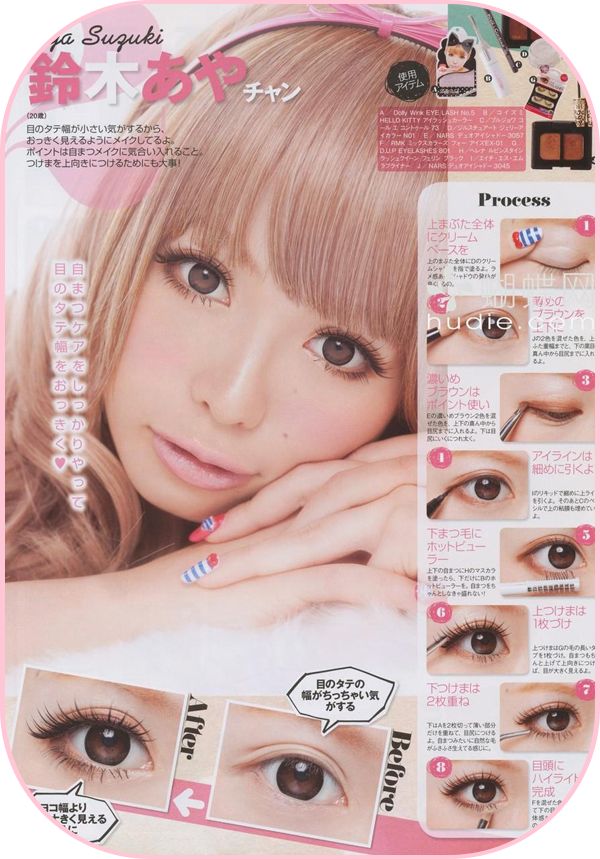
photo credit: pinterest
Sottogeneri e il Principe
Il mondo lolita è davvero molto vario ed elaborato, esistono generi per tutti i gusti. Il Wa Lolita ad esempio è un mix tra i vestititi lolita e le stoffe dei Kimono tradizionali, con Obi ad adornare la vita e i classici sandali Geta come calzature; Il Qi Lolita che si riffa allo stille Cinese dove al posto dei Kimono si modificano i qípáo; il Sailor Lolita che si basa sulla classica divisa scolastica con la sua variante più elaborata; o ancora il Pirate Lolita.
E se si pensa che lo stile lolita sia solo “zucchero e cannella” abbiamo anche il Guro Lolita. Qui le lolita si ispirano all’horror con sangue finto che risalta su candidi abiti bianchi per dare l’idea di essere bambole di porcellana in frantumi.

photo credit: pinterest
Ma ci sono davvero molti altri esempi da citare. Una nota particolare bisogna farla però per lo stille Ōji (王子 principe) per chi crede erroneamente che la moda lolita sia solo femminile. Lo stile Principe si basa sui modelli di vestiti usati dai giovani Dandy Vittoriani e qui vediamo la comparsa di pantaloncini corti e calze al ginocchio. Questo però non significa sia solo maschile. Se una ragazza si affacciasse al mondo lolita ma volesse avere uno stile più androgino questo tipo di abbigliamento fa per lei.
I must have, i vari Brand, anime e l’influenza fuori dal Giappone
Esistono alcuni oggetti di culto che ogni Lolita che si rispetti possiede nel proprio guardaroba: le Cutsew, camicie con enormi fiocchi e maniche a sbuffo o le Petticoat ovvero sottovesti per ampliare i vestiti e le gonne. Per chi si domanda invece come fanno le Lolita ad avere dei capelli tanto meravigliosi e folti … beh, sappiate che sono parrucche. Le lolite le decorano poi con enormi fiocchi e i Bonnet, i classici cappelli di una volta, e le scarpe iconiche sono modello Mary Jane. Queste, anche se nate all’inizio del secolo scorso per i bambini ormai sono le scarpe che ogni lolita che si rispetti indossa.

photo credit: pinterest
Oltre il brand di Mana-sama, altri molto conosciuti sono Angelic Pretty, e Baby, The Stars Shine Bright quest’ultima con boutique non solo a Tokyo ma anche a Parigi e San Francisco. Bisogna ammettere che la moda lolita è molto dispendiosa, ma esistono Indie brand belli quanto le marche più famose ma sicuramente meno dispendiose. Ed in Giappone è possibile acquistare abiti lolita anche nei grandi magazzini e volendo ci sono siti web appositi per comprare abiti lolita di seconda o terza mano. In altre parole è diventata una moda per più tasche.
Il fenomeno lolita ha trovato la sua strada anche in molti anime di successo. Esemplari sono Paradise Kiss di Ai Yazawa meglio nota per essere la mamma di Nana; Princess Princess anime dove la moda lolita e vista tramite gli occhi di tre ragazzi; Le Portrait de Petit Cossette, versione femminile e Noir del ritratto di Dorian Gray; e Rozen Maiden dove protagoniste sono appunto delle bellissime bambole.
Come già detto, le Lolita non sono famose solo in madre patria, ma dall’America a tutta l’Europa si possono incontrare piccole comunità di Lolita. Queste si riuniscono in raffinate Tea House per celebrare il Tè delle cinque con la classe e lo stile che le differenzia da qualsiasi altra moda.
Japan Tradition: Seijin Shiki
Seijin Shiki
Seijin Shiki anche conosciuta come Seijin no Hi (成人の日) è il giorno della Maggiore età. Questa è una festa giapponese che si tiene ogni anno il secondo lunedì di gennaio. Lo scopo di questo giorno è di congratulare ed incoraggiare tutti coloro che hanno compiuto il ventesimo anno di età, l'età della maturità (二十歳 hatachi), nell'anno passato.
In questo giorno, molto giovani giapponesi celebrano con una cerimonia per il Giorno della Maggiore età, il Seijin-Shiki (成人式). Le feste per questa giornata sono spesso tenute negli uffici della prefettura e in locali. Tuttavia, molte persone fanno delle feste con la famiglia e gli amici successivamente. E' anche comune vedere questi giovani camminare per strada indossando i vestiti tradizionali.
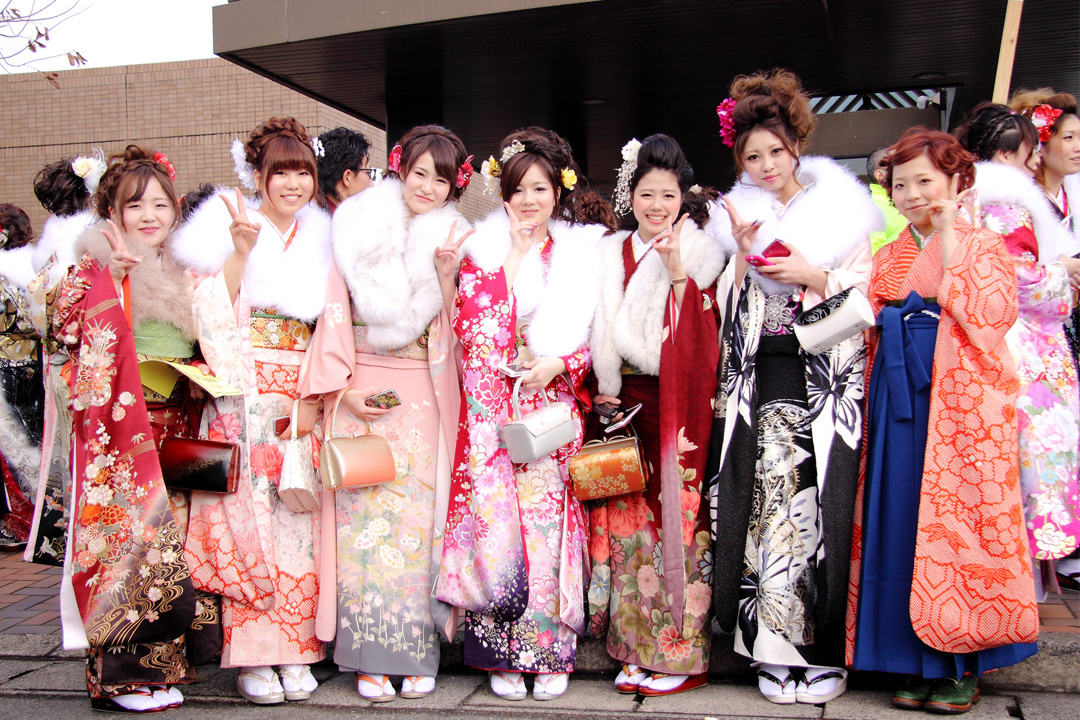
Shinjin Shiki, la cerimonia per la Maggiore Età, data indietro al 714 in Giappone. In questo anno, un giovane principe ha acquisito nuovi vestiti e acconciatura per marcare il passaggio all'età adulta. Tuttavia, questa festa è stata stabilita per la prima volta nel 1948 e si celebrava ogni 15 gennaio. Più tardi nel 2000, la data per il Seijin Shiki è cambiata ed ora si celebra il secondo lunedì di gennaio.
Solo coloro che hanno compiuto il ventesimo compleanno prima dell'ultima Festa della maggiore età o prima di quella attuale può unirsi ai festeggiamenti.
Seijin Shiki celebrations
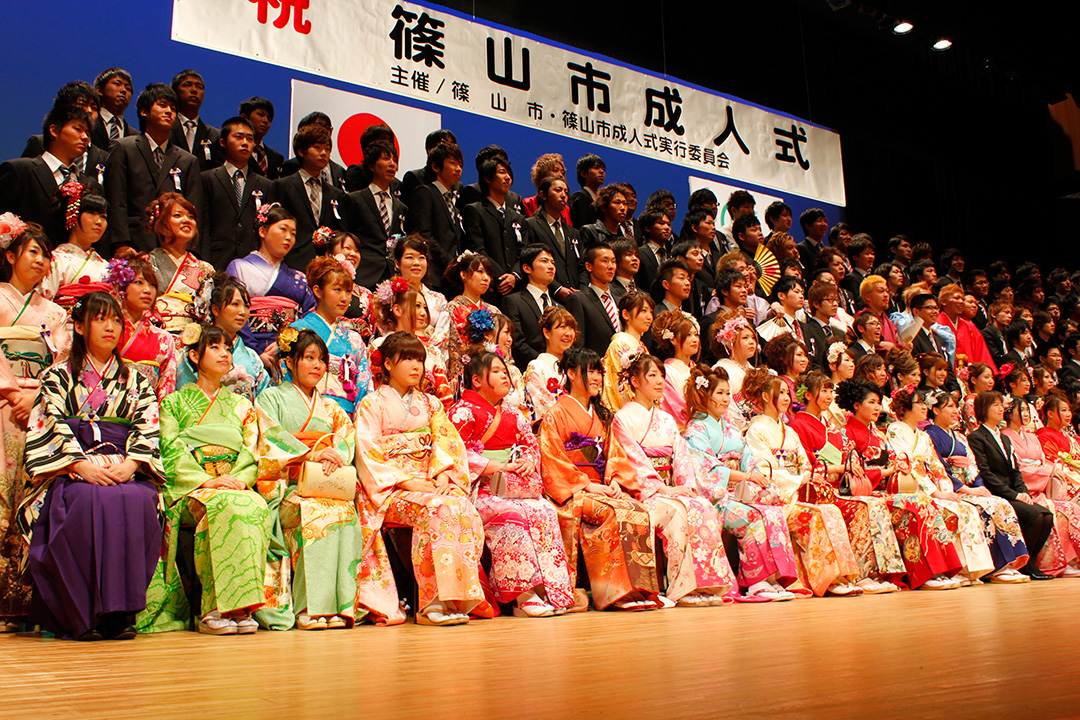
Sijin Shiki segna l'età della maturità, che include l'espansione dei diritti ma anche l'aumento delle responsabilità previste. Di solito, gli ufficiali governativi fanno dei discorso e la famiglia e gli amici fanno dei piccoli regali ai nuovi adulti.
Le donne solitamente celebrano indossando furisode e sandali zōri che possono comprare, prendere in prestito da un parente o affittare per l'occasione. Anche gli uomini indossano vestiti tradizionali, come kimono scuri con hakama, ma oggi è anche comune vedere uomini che indossano giacca e cravatta.
Dopo la cerimonia formale, spesso escono in gruppi per festeggiare e bere con gli amici.
Photo credit: Google images









